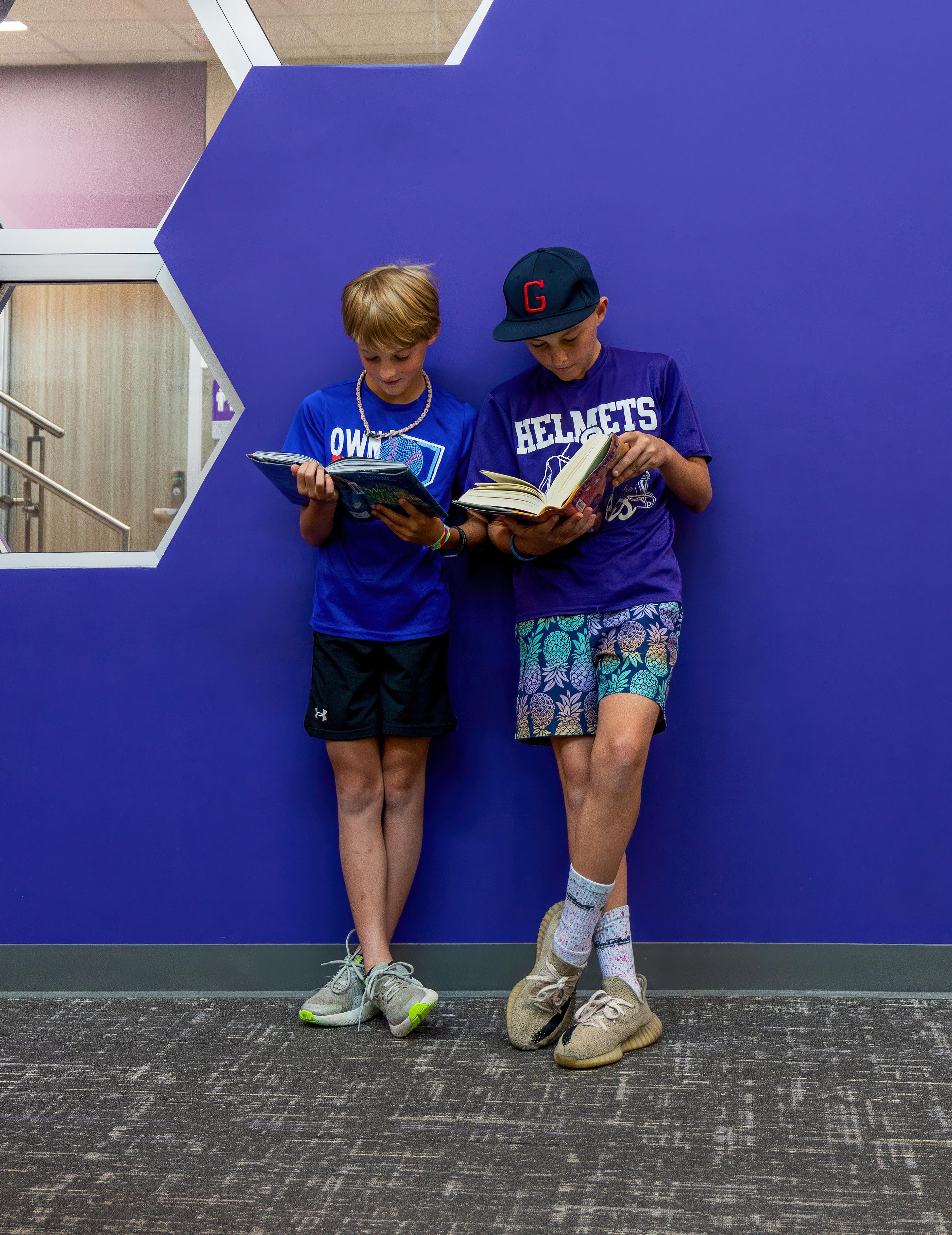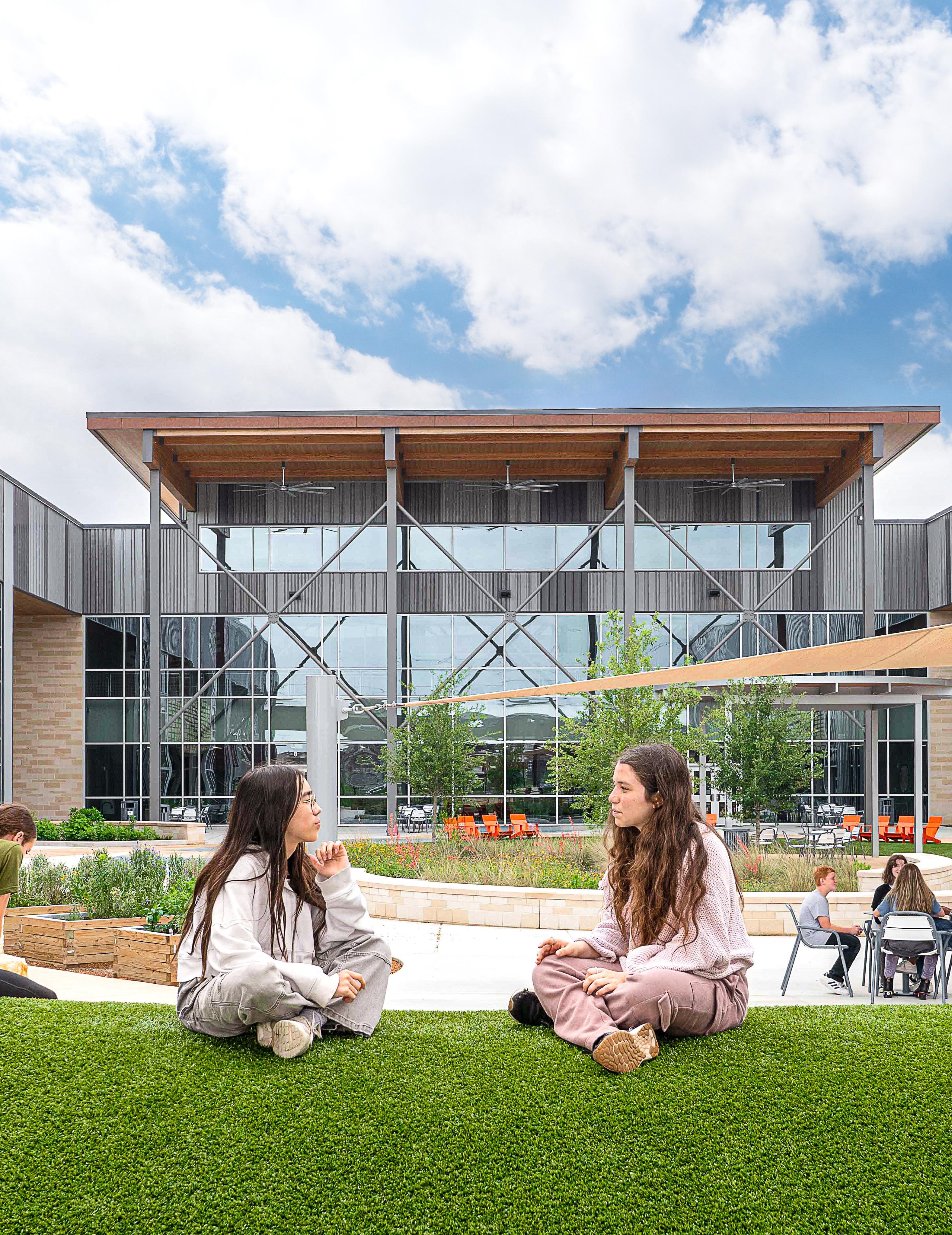




Volume 12 | 2025
Welcome to the latest edition of Experience, a publication dedicated to shining a light on the vision, creativity, and innovation that define VLK—where architecture is only the beginning of our story. As you turn these pages, you’ll embark on a journey that celebrates a new chapter in the evolution of our practice. This edition is more than a catalog of beautiful spaces; it is a showcase of how VLK continues to level up—beyond architectural design and in the profound ways we deliver educational thought leadership and services, demonstrating our talents that extend far beyond the boundaries of architecture itself.
Of course, design remains at the heart of our work. Whether it’s a new school, a transformative renovation, or a project that assists a client with an addition due to growth needs, our architects and designers listen deeply and respond thoughtfully. The stories in this edition reflect a firm that never settles; we challenge ourselves and our partners to imagine, discover, and implement the next layer of excellence in every project.
We believe that leveling up is not a destination but a continual process of growth. It means seeking out new challenges, embracing the spirit of lifelong learning, and remaining open to possibilities yet unrealized. This commitment is expressed in the boldness of our designs, the depth of our collaborations, and the impact we seek in every community we serve. VLK is committed to walking alongside educators, students, and families as they bring these spaces to life.

DALANE BOUILLION, E d .D. CHIEF DEVELOPMENT OFFICER

DANIEL PITCOCK CHIEF EXPERIENCE OFFICER




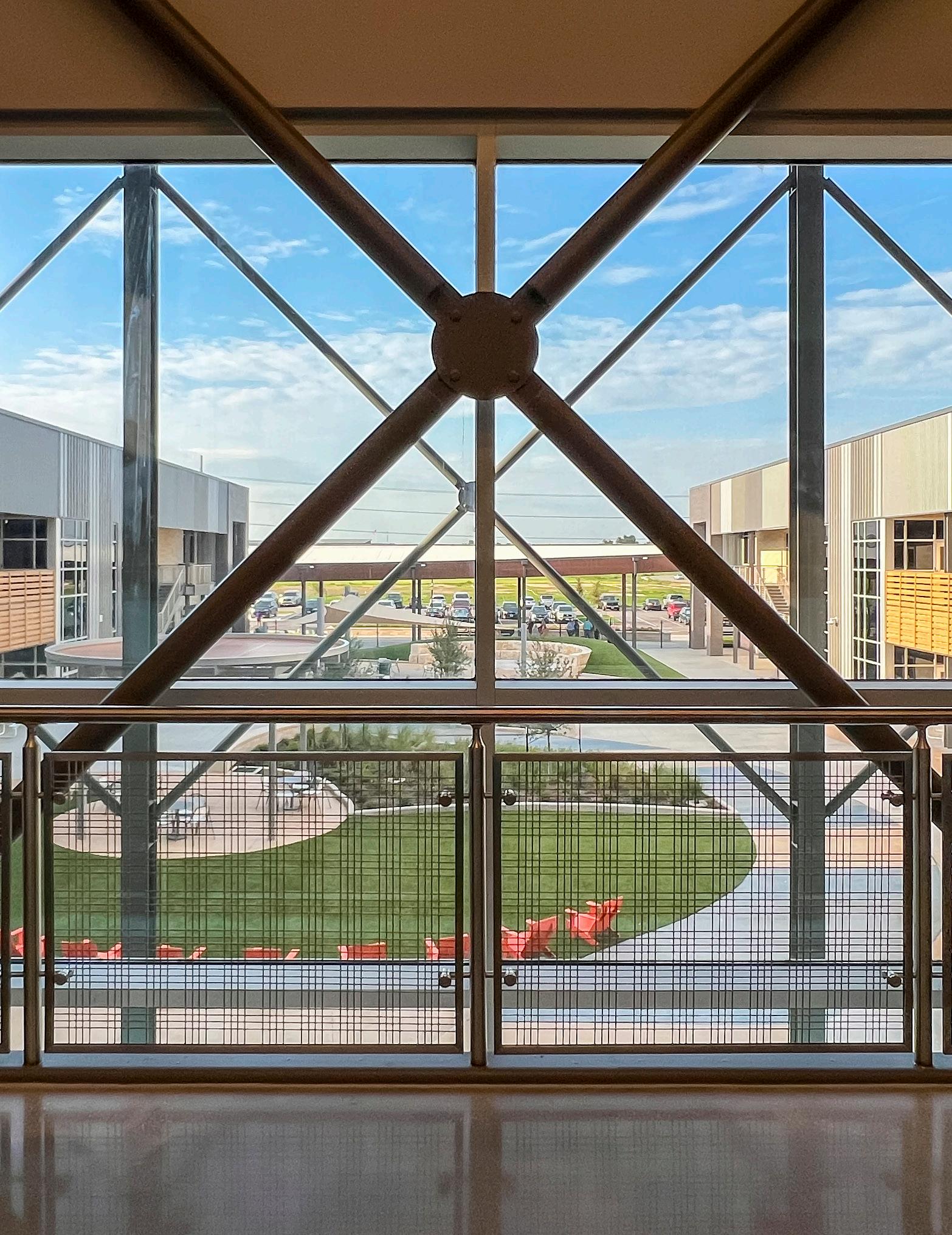
How One District Transformed 26 Acres into a Future-Ready Middle School

School administrators today are being asked to square an almost impossible circle: deliver inspiring, personalized learning experiences while safeguarding tight operating budgets—and do it all in buildings that can flex with tomorrow’s unknowns. On a compact 26 acre parcel in Central Texas, Hutto ISD answered that call by embracing VLK’s inspiration: the geode. Unassuming on the outside, radiant within, the new Gus Almquist Middle School redefines school design by prioritizing student experience, space efficiency, and material simplicity.
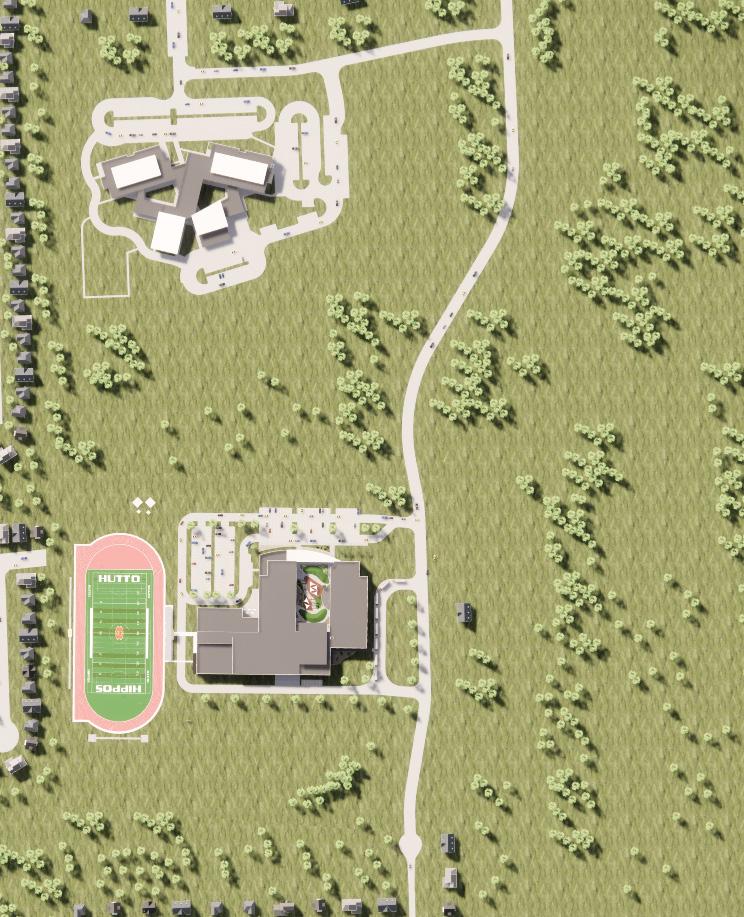
The project avoided extra real estate costs and preserved green space by utilizing open land on an existing campus site. By building on a section of an existing elementary school site, the project eliminated the need for costly land acquisition and preserved surrounding green space. This strategic decision not only supported the district’s budget priorities but also maintained a strong connection to the community and existing campus infrastructure.
Launched during the uncertainty of the COVID-19 pandemic, the team adopted a do more with less approach, reducing square footage and carefully selecting materials without compromising functionality or vision. Early cost reduction strategies were discussed with the district in Design Development to ensure that the elements that aligned with the core values of the project would remain.
At the heart of the campus design lies a dynamic courtyard—a sun filled space that dissolves the traditional boundary between indoor and outdoor learning. Collaborating with teachers during design to support TEKS-aligned, active learning, the courtyard offers direct access from science, CTE, art, and general education classrooms, creating immediate opportunities for students to connect academic content to hands-on applications. From scaled solar system models to practical math activities, this dynamic space brings curriculum to life in tangible and meaningful ways. With more than half of the general classrooms directly overlooking the courtyard, the design boosts supervision, safety, and connectivity, acting as the unifying thread that links teaching and learning while fostering an inclusive, safe, and engaging environment.
Traditional stages rely on side loading stairs or narrow lifts that can marginalize performers with mobility challenges. Here, a broad, centrally located ramp folds seamlessly into the audience zone, making the act of coming to the stage a shared experience.

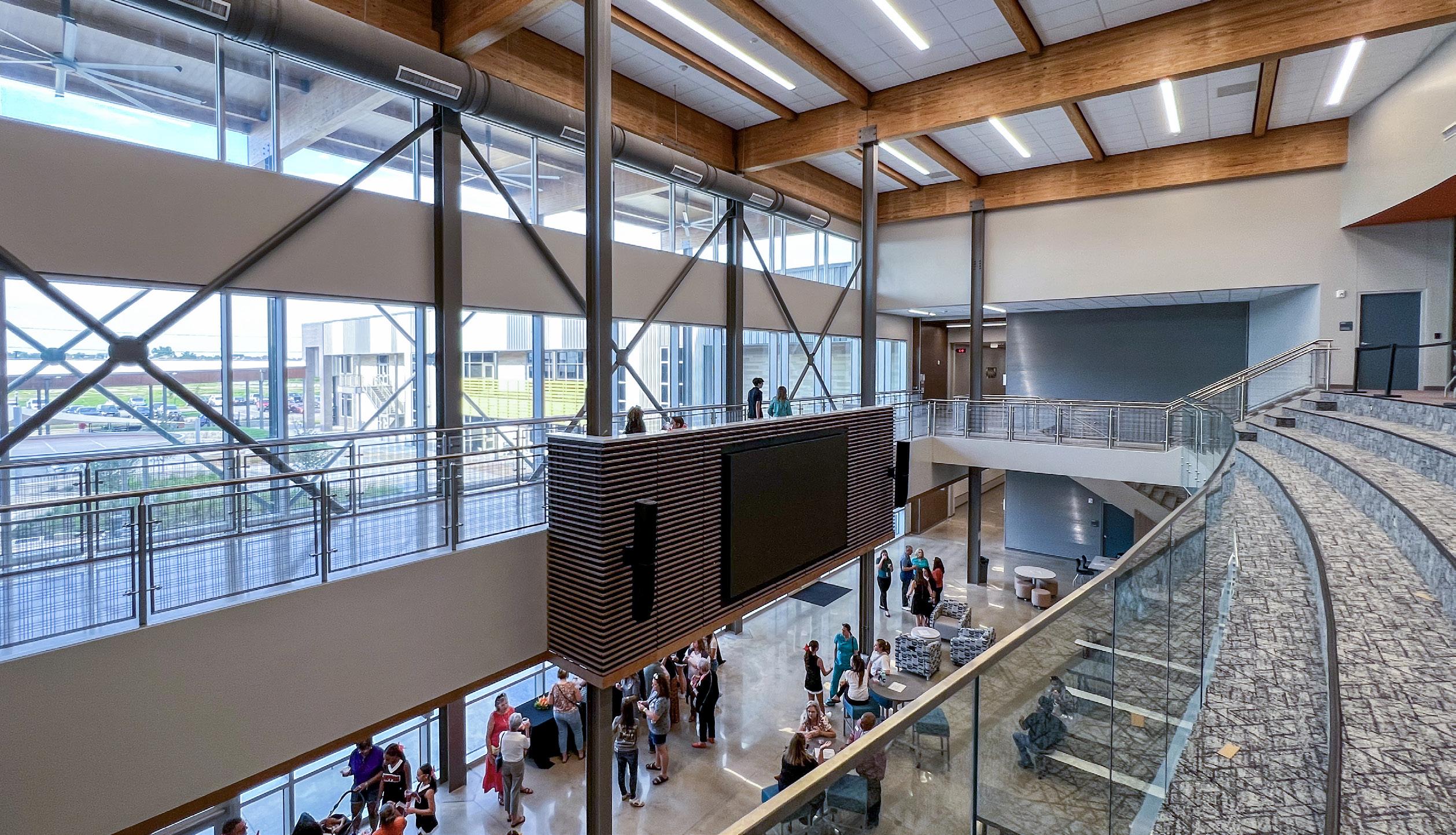
“
“ We
strive to be a district of innovation looking to the future where learning needs to be, and this is what this building symbolizes.
A vibrant esports arena anchors the campus, sparking student engagement through competition and innovation. The esports arena seamlessly connects to an elevated library, blending the energy of competition with the inspiration of literature in a way that reflects the evolving nature of student interests and learning.

Designed to spark curiosity and ignite a passion for what’s next, the CTE and robotics spaces empower students through hands-on, exploratory learning with real-world relevance. These flexible environments encourage tech-integrated, careerconnected learning, with classrooms that flow naturally into the courtyard. Built for both today and tomorrow, these adaptable spaces support current programs like robotics while remaining ready to evolve with future district needs and student interests.

Rooted in inclusive design, the centrally located, accessible pathway transforms the stage into a place where every student feels seen, valued, and included offering all learners the same shared way to take the spotlight. Positioned at the front, not off to the side, it reimagines performance spaces by removing barriers and inviting every student to shine with confidence and belonging.
Overlooking a vibrant courtyard, the stage, cafeteria, and classrooms are filled with natural light, outdoor access, and views of the district-wide mascot creating a bright, welcoming environment that supports well-being and school pride.
The courtyard, alive with performances, active learning, and community events, serves as an energetic hub for connection and celebration. At the heart of campus, a one-of-a-kind esports arena connects to an elevated library, blending the inspiration of literature with the energy of competition.
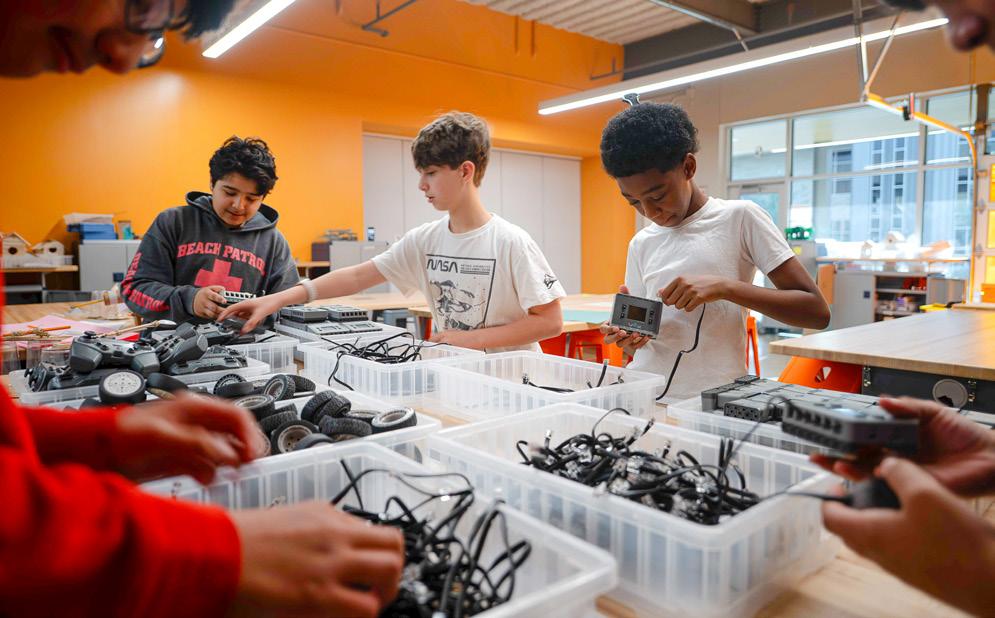
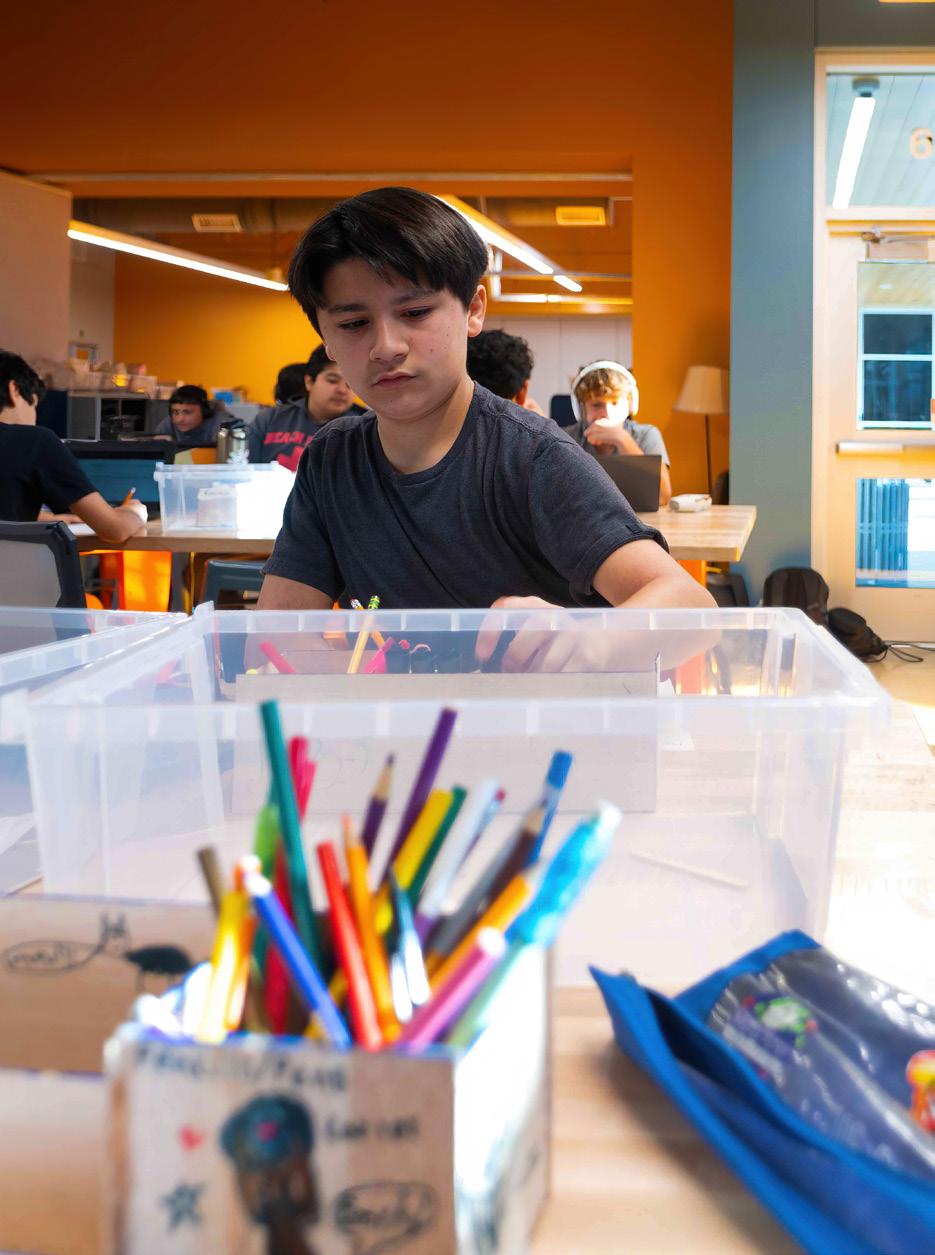

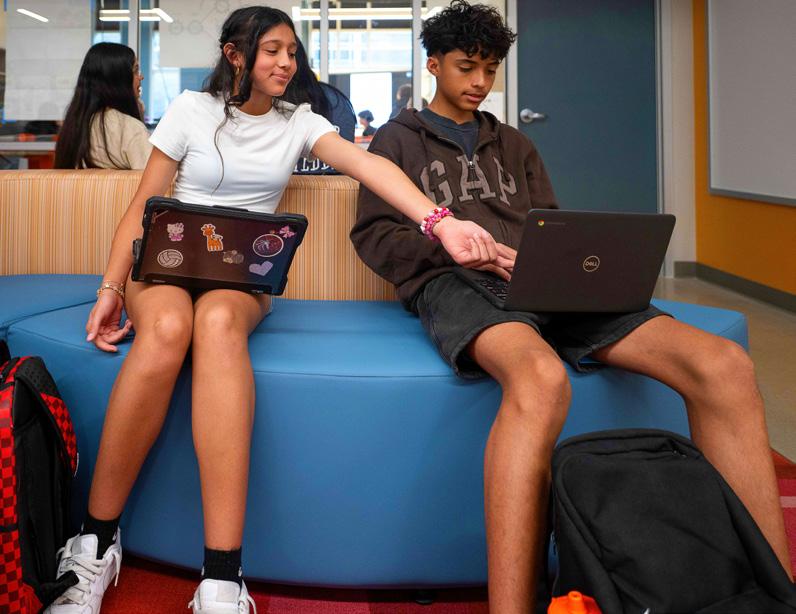

Like a geode, the campus presents a humble, understated exterior that opens to reveal a vibrant, dynamic interior full of innovative student-centered experiences.

Bursting with school spirit, the campus proudly celebrates a shared, beloved Hutto Hippo playfully featured at both the main entry and courtyard, as a unifying and welcoming symbol for students, families, and the broader community. This familiar icon, embraced by local businesses and recognized across the district, brings smiles and sparks a sense of belonging for learners. Captivating graphics, pops of bright orange, and words of encouragement are woven throughout the campus creating a vibrant, welcoming environment. These bright visual cues strengthen students’ sense of pride and belonging, making the campus feel inspiring and uniquely theirs.




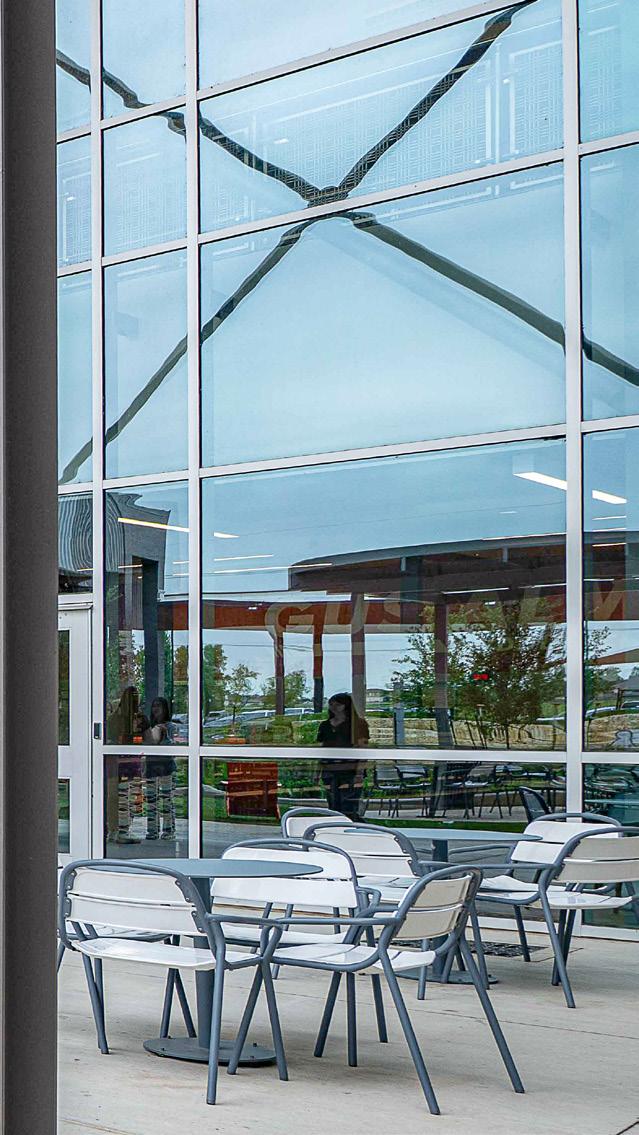
The courtyard provides a secure, welcoming space where students feel safe to explore, create, and connect.
The campus provides the perfect balance of competitive space and community atmosphere. The courtyard gives our students a chance to connect with other teams, while the facility layout keeps everything organized and accessible. It quickly became a favorite robotics competition venue for teams in and around the community.
Effectively and efficiently using your buildings to minimize operational funding.
CLINTON SCHIVER | PRINCIPAL
CHAD DAVIS | SENIOR ASSOCIATE, FACILITY PLANNER
FAITH ANN HARDCASTLE | ASSOCIATE, ARCHITECT
Management author and guru, Peter Drucker said, “Efficiency is doing things right, effectiveness is doing the right thing.”
It is becoming increasingly critical to minimize operational funding of school facilities given the State’s lack of appetite to adequately and properly fund public schools. Learning how school buildings can be evaluated for their efficiency and efficacy can lead to better decision making and increases in both efficiency and efficacy; saving funding for those needs that are most directly related to the core mission. These goals can be achieved during the design process of new facilities, or at any time using a post occupancy evaluation.
Efficiency and effectiveness are crucial aspects of a school’s operation. Efficiency pertains to how well a school utilizes its resources to meet its objectives, while effectiveness focuses on the extent to which a school accomplishes its goals related to student learning, development, and well-being. It is noteworthy that enhancing effectiveness typically results in improved efficiency, showcasing the interconnected nature of these two vital components in the educational setting.
Teaching station: Any space where a teacher is commonly scheduled, which includes classrooms, but also CTE labs, gymnasiums, fine arts spaces, or even a lecture hall.

Maximum capacity: The total number of teaching stations multiplied by the number of available student seats in the teaching station.
Efficiency is doing things right, effectiveness is doing the right thing.
“
Functional capacity: The number of students that a school can accommodate while still functioning effectively. It is calculated by applying a utilization factor to the maximum capacity. At elementary schools, the industry standard utilization factor is 90%. For secondary schools, the utilization factor is determined by the bell schedule. An eightperiod day with one teacher planning period per day uses each teaching station seven out of eight periods, or 87.5% of the day.
It’s essential to harmonize efficiency with effectiveness to optimize the learning environment.
“
Calculating capacity at an elementary school is straightforward. By tallying the number of grade-level classrooms and multiplying by 22 students per classroom, we arrive at the maximum capacity. However, achieving this maximum capacity is often unattainable due to the irregular grouping of students. Therefore, instead of aiming for maximum capacity, we focus on a functional capacity figure. It’s essential to note that spaces dedicated to enrichment activities such as art, music, and the gymnasium do not factor into the overall capacity calculation, as they are utilized only when classrooms are vacant. As an example, when Mr. Harris takes his 4th grade class to art on Thursdays, it leaves their homeroom empty.
Capacity at secondary schools have an expanded group of instructional spaces, including athletics, fine arts, and CTE in addition to the core curriculum classrooms.
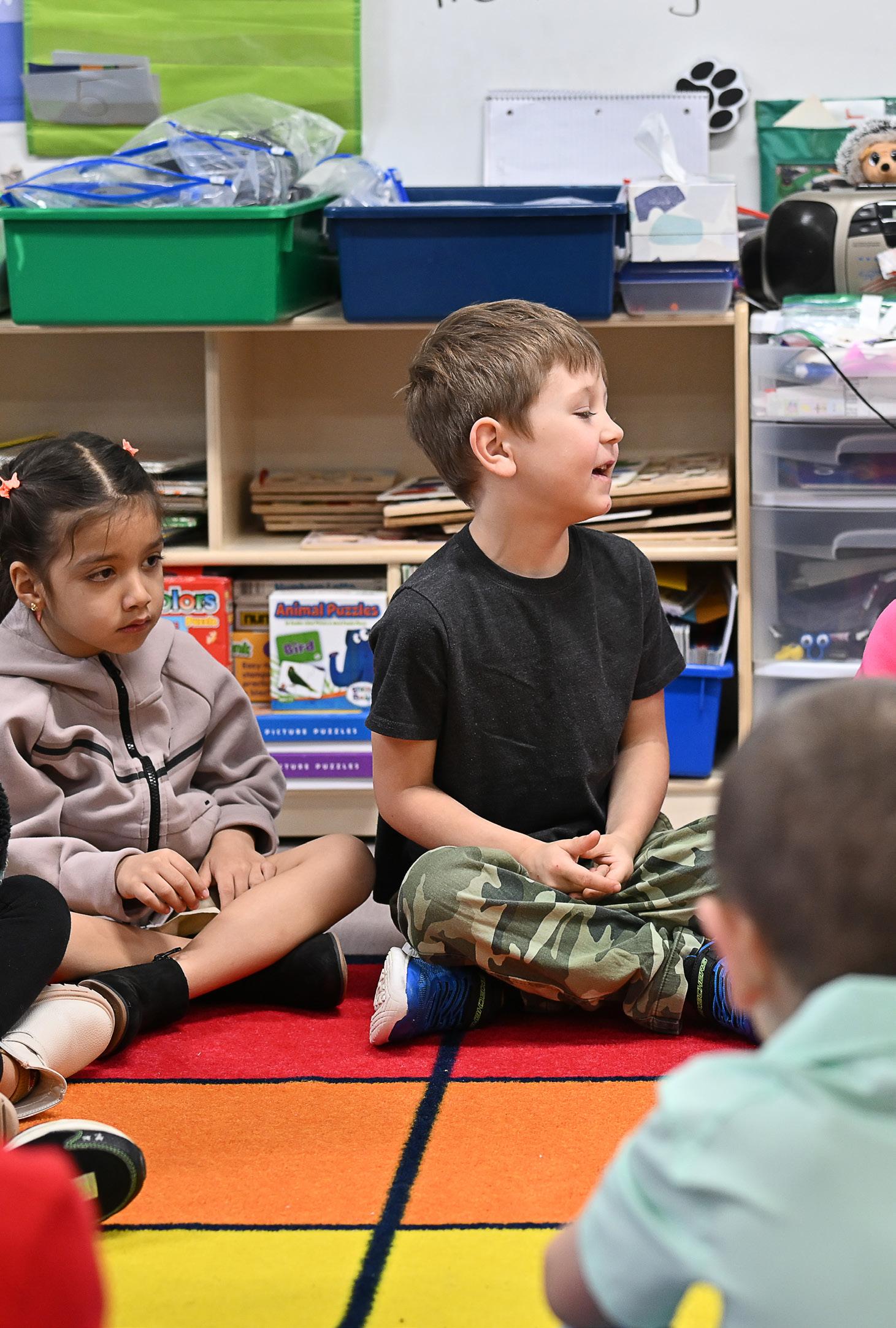
School districts encounter budgetary hurdles due to inflation, varying enrollment numbers, and inadequate state funding. To address these challenges, districts can strive to maximize the utilization of every dollar allocated to construction and facility operations. When opening a new school, it is designed specifically for needs at that point in time. However, based on our observations the efficiency of space utilization within a school tends to diminish as time progresses. As expected, each campus organically changes year to year to align with course offerings, number of needed sections of courses, teacher professional development and partnering, planning and conference periods, updated state requirements, and other student needs. After several years or decades of these changes the overall efficiency and efficacy of the building can be reduced drastically. This often requires analysis; a purposeful pause and assessment followed
by a reset. This reset can occur during the planning process of capital improvements, be initiated on instinct, or become a planned recurring process. VLK | LINK® is our long-range facility planning and bond support process. This includes analysis, checkpoints, and procedures to uncover potential ineffective or inefficient usages at every campus in the district. This provides multiple opportunities to confirm campuses are in alignment with educational and operational goals.
When VLK partners with school districts for long range planning, our experience has shown that it is essential to assess the current utilization of the building. Analyzing the master schedule and floor plan in detail can reveal opportunities to enhance efficiency by maximizing the usage of each instructional space. Additionally, optimizing room sizes is crucial.

Our expertise helps clients identify some of the most common inefficiencies that exist in school district facilities and practices using a proper long-range planning process. Through our experience we have seen inefficiencies such as:
• Speech therapy, counseling, and other special education programs are frequently assigned to fullsize classrooms due to a shortage of small rooms or offices
• Bell schedules change, making changes to the master schedule creating ineffective use of existing spaces
• Instructional spaces are used for a fraction of the periods of the school day, such as by specialized CTE teachers or coaches
• Portables exist on a campus as a long-term solution
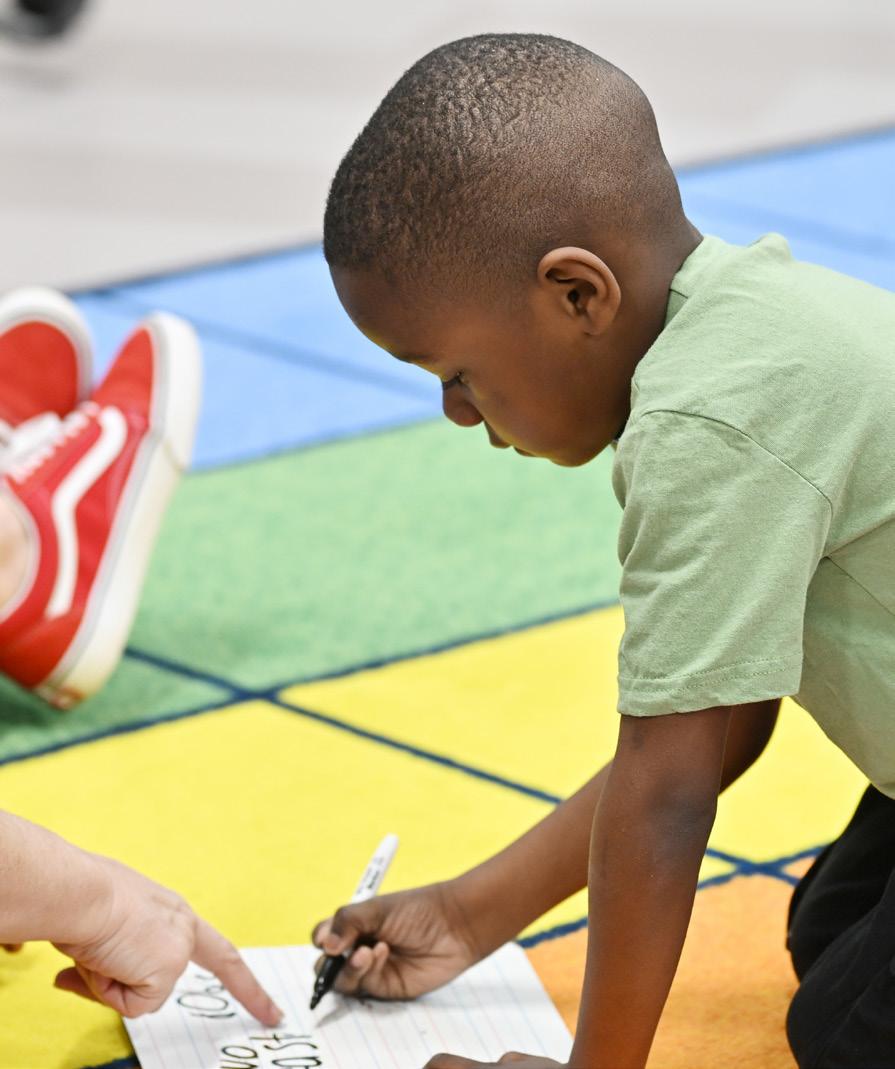
Maximizing efficiency in your building can be a game-changer. Consider the following solutions to the common inefficiencies presented above.
• Transforming a single classroom into multiple smaller spaces for these instructional support purposes can help reclaim valuable real estate by providing the right-sized spaces for the support services which then allows the other classrooms to be returned to instructional spaces.
• By adjusting the bell schedule, a significant boost can be achieved in the building’s efficiency.
• If a school currently operates on a block schedule with 4 periods per day and 1 teacher planning period, it is running at only 75% efficiency. Why? Because at any given time, 1 out of 4 instructional spaces remains vacant.
• A school that operates an 8-period day with 1 teacher planning period is utilizing classroom spaces 7 out of every 8 periods, elevating your efficiency to 87.5%. That’s a notable 12.5% efficiency gain. In a 2,500-student high school, this bell schedule adjustment would create space for an additional 300 students. Imagine accommodating all 2,500 students with 14 fewer instructional spaces just by modifying the bell schedule.
• In an eight-period day, including one planning period and three coaching periods, coaches are often away from the classroom, leading to numerous unoccupied instructional spaces. As a result, their classrooms remain empty for 50% of the school day. This creates an opportunity to float a teacher into empty rooms. Please note that not every teacher has to float to be able to get increased efficiency from this strategy.
• While portables are not an inefficiency of utilization, they do often represent that an inefficiency is present and can be used as a red flag to initiate a utilization study.
Capacity planning in schools is a crucial aspect that requires a delicate balance of art and science. The calculation of building capacity often overlooks the actual utilization of the space. It’s essential to harmonize efficiency with effectiveness to optimize the learning environment. Striking the right balance ensures that the school maximizes its capacity while aligning with the desired teaching and learning outcomes. VLK works collaboratively with our client partners to explore options that align with the ®®strategic district and long-term vision of the district to provide custom sustainable, effective, and efficient solutions.
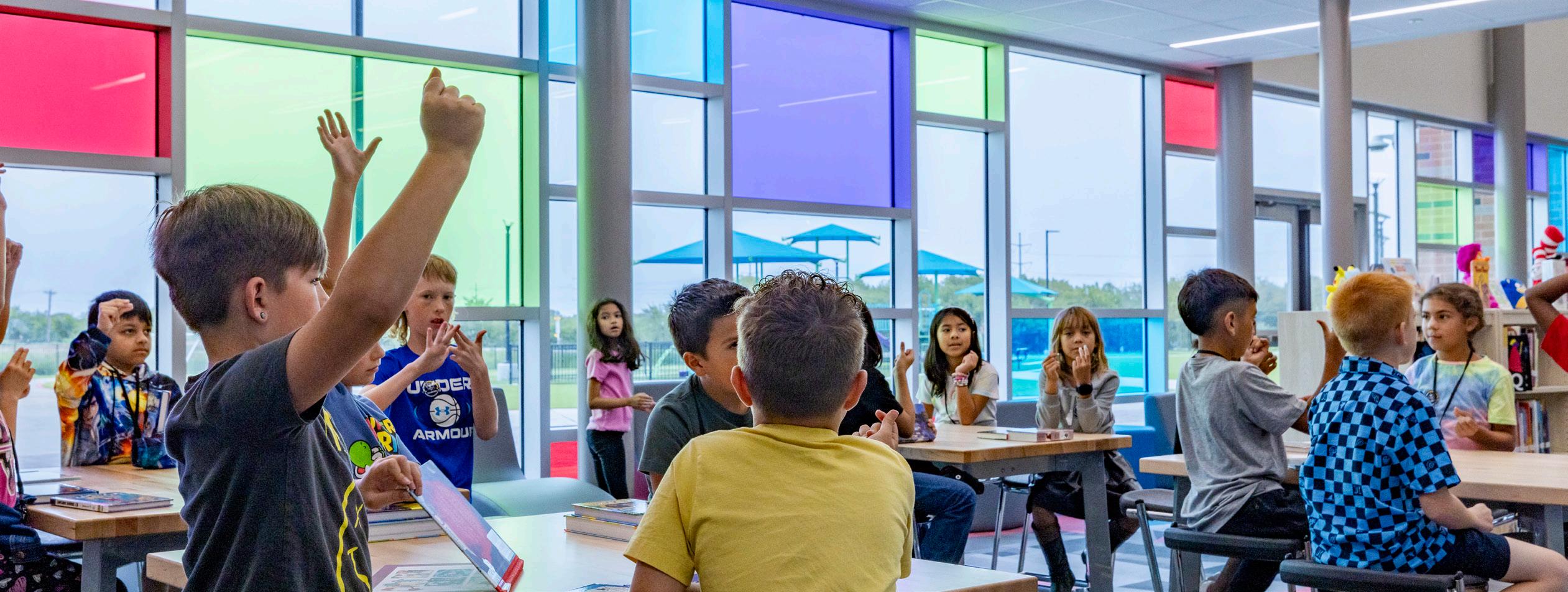
SCOTT MILDER | PRINCIPAL, K-12 EDUCATION SPECIALIST
Public schools are the foundation of Texas’s prosperity. Our state’s economy is one of the largest in the world, fueled by a skilled workforce educated in Texas public schools. Despite their critical role in our success, our schools are under attack—underfunded, politicized, and increasingly burdened with mandates that hinder their ability to focus on what truly matters: educating our children.
Few organizations in Texas understand this better than VLK, the state’s leading architectural firm specializing in K-12 school design. By helping hundreds of school systems over the last 40 years make sure they have the facilities infrastructure to adequately serve their student populations, VLK professionals have witnessed first-hand the great work and dedication of Texas’s highly trained
professional educators. Unfortunately, we’ve also seen the state actively work against the incredible efforts of our educators. That’s exactly why I joined VLK. In 2018, I had the privilege of becoming part of this team to help lead our advocacy efforts in support of public education.
As Texans, we take pride in our independence, our innovation, and our economic strength. But none of that happens without strong public schools. Every industry in our state relies on the graduates of our public schools to drive our economy forward. From doctors and engineers to teachers, welders, business owners, oil and gas workers, and many more, our schools prepare students for success in college, career, and life. Sadly, instead of celebrating and investing in
our schools, our state’s top politicians continue to politicize them, pushing policies that undermine their ability to do their jobs. Texas public schools are doing more with less than ever before.
The state’s investment in education funding has steadily declined with each passing year while Governor Abbott and other politicians falsely claim our schools have more funding than ever before, which is simply not true. (Texas AFT) Meanwhile, inflation, teacher shortages, unfunded state mandates, and policy that has legislated the art of teaching out of the classroom have made it exponentially harder for schools to continue providing the high-quality educational experience Texas families are accustomed to receiving.
The fundamental purpose of public education is to serve the public good. It is not to serve as a profit-driven enterprise, or a selective institution that only serves a privileged few. It exists so that every child, regardless of background, income, ability, disability, or zip code, has access to a free and appropriate education that prepares them for life as informed, capable citizens. That’s why we all pay school taxes—even those without children in school—because an educated society benefits everyone. We do not pay school taxes to educate our own children. We need well-trained doctors, skilled engineers, ethical business leaders, responsible law enforcement officers, effective teachers, and capable workers in the many trades that keep our communities, homes, and businesses functioning. Public schools are the mechanism by which we ensure our state remains competitive, innovative, and strong. It’s a constitutional obligation in the hands of our Texas Legislature. The Texas Constitution mandates that the state fund and maintain a system of free public schools. Article 7, Section 1 states:
A general diffusion of knowledge being essential to the preservation of the liberties and rights of the people, it shall be the duty of the Legislature of the State to establish and make suitable provision for the support and maintenance of an efficient system of public free schools.
Yet, instead of fulfilling this duty, state politicians are failing our students and communities. They continue to defund public education while attempting to convince Texans that their local schools are failing and mismanaging public funds.
Let’s be clear: the argument that Texas public schools are failing is fundamentally wrong, and frankly, dishonest. By what measure are these widespread accusations of failure cast on our public schools and educators? The only measures critics point to are A-F accountability ratings, which are almost exclusively determined by student performance on deeply flawed, state-mandated, standardized STAAR tests, which are not even aligned with the Governor Abbott and Texas Legislature-approved Texas Essential Knowledge and Skills (TEKS), the very curriculum Texas students are taught. These tests do not measure the full depth of the student experience—they are used as a political weapon to label schools and teachers as ineffective in order to promote their agendas.
Beyond that, many of the attacks on public schools rely on nothing more than rhetoric—talking points repeated by talking heads and politicians with no sourced data (or manufactured data) to back up their claims. One outrageous anomaly happens somewhere in America and the talking heads and politicians declare widespread indoctrination. The narrative of failure, in Texas at least, is a lie designed to erode public trust and justify the dismantling of public education in favor of privatization of public education.
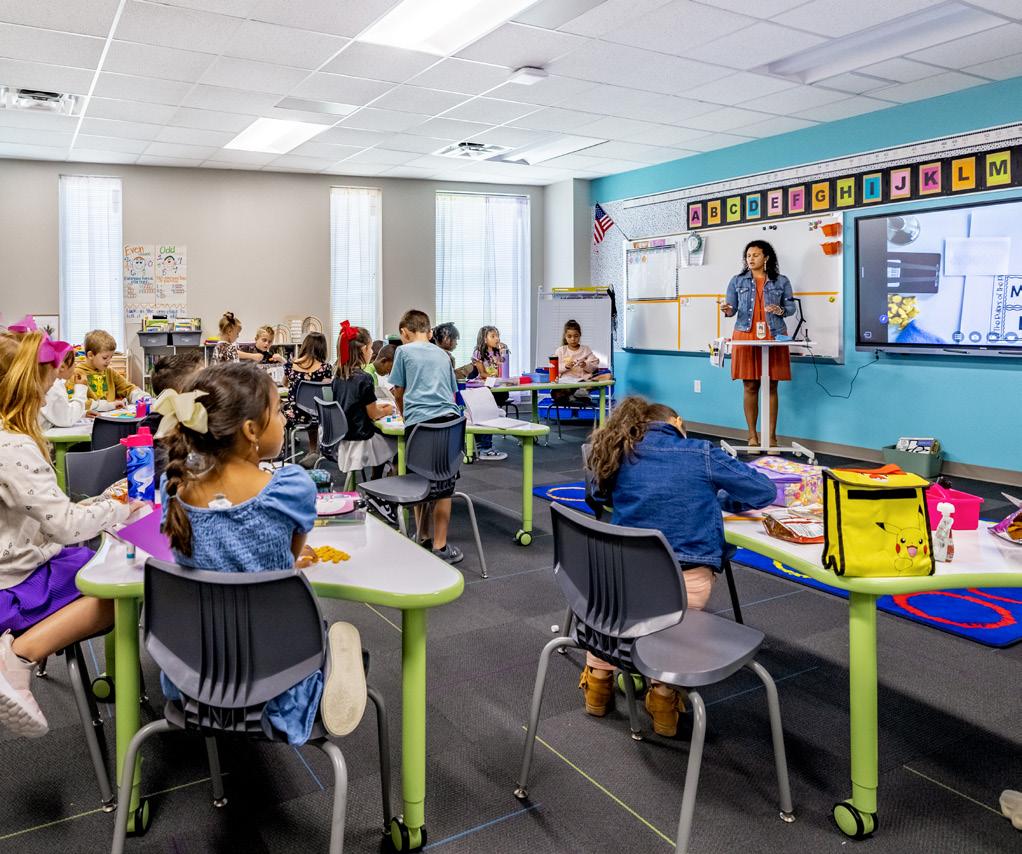


Some claim that Texas public schools are better funded than ever before. Wrong! When adjusted for inflation, per-student funding has declined by 20% over the last five years. And this funding decline has been exacerbated by the unfunded mandates the state continues to pile onto our schools. Aside from some additional funding for a few specific segments of school operations, like special education, the Texas Legislature has not invested additional funding in its public schools since 2019. Sadly, Governor Abbott held hostage an additional $5 billion that had been allocated for our schools last year. He would not allow the funding to flow to our schools if the Legislature did not pass his voucher bill. Seems to me if his bill had any merit it could stand on its own.
Overall funding has decreased because a top political priority of the Texas Legislature is property tax relief, which I’m all for as long as the state replaces the local decrease with an alternative revenue stream. The mechanisms for achieving this property tax relief are increasing the homestead exemption and forcing compression of local tax rates with promises of making up the difference by injecting state funds. The state of Texas has not kept this promise.
I live in Rockwall. Let’s say my house is valued at $400,000. When the homestead exemption was only $25,000 two years ago, Rockwall ISD collected taxes on $375,000 of my home value. The Texas Legislature increased the homestead exemption to $100,000 last year, and now Rockwall ISD only collects taxes on $300,000 of my home’s value. Although the state promised to make up the difference with state funds, it has not.
The Texas Constitution is clear: funding public schools is the state’s duty. Our politicians are not living up to that duty. They are playing an intense game of politics with our schools, and more grotesquely, with our students’ educations.
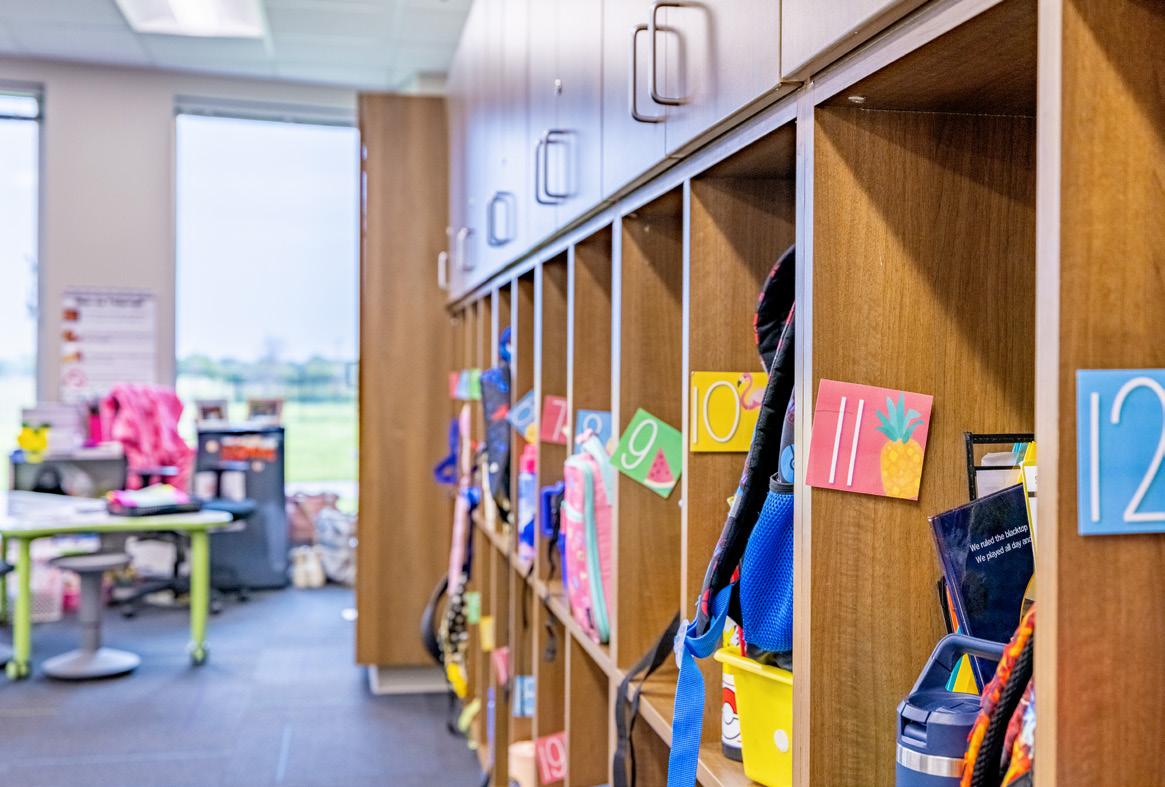
Another myth suggests that Texas public schools are failing because students are graduating without basic skills. This claim is not only false but insulting to the hundreds of thousands of educators who dedicate their lives to teaching our children. Are there challenges? Of course—particularly in underfunded schools and economically disadvantaged communities. But the idea that students are walking across the graduation stage illiterate is a ridiculous lie. There are many hoops every student must jump through to demonstrate mastery of the courses required to graduate. What are these claims based on? Standardized tests. And here’s the problem with that: These tests are deeply flawed and arbitrary. They measure a student’s ability to take a test, not their ability to think critically, problem-solve, work on a team, or apply what they’ve learned. They ignore real growth and achievement in our schools. Public schools offer far more than just test scores—they provide students with experiences in career and technical education, the arts, leadership opportunities, and hands-on learning that standardized tests fail to measure. The real question is this: If public schools are “failing,” then by what measure? And who gets to decide? Texas students are excelling in countless ways. They are earning industry-based job certifications, participating in national academic and fine arts competitions, and graduating prepared for college, with college hours already completed, and sometimes with associate degrees. Public schools do not produce failure—they produce the future leaders and productive citizens of our state.
Perhaps the most dangerous myth being pushed today is that public schools are centers of political indoctrination. Let’s be clear: This is a manufactured crisis. Teachers are not political activists. They are professionals—highly trained educators who dedicate their lives to teaching, not indoctrinating. The curriculum used in Texas classrooms is written and approved by the state, aligned to TEKS, and reviewed extensively before it reaches students. In fact, there is so much content and curriculum prescribed by Texas that there is very little room for any educator to inject their personal agendas or rogue curricula. Every minute of the day has been scripted. The art of teaching is all but gone, thanks to know-it-all legislators and the governor. If our schools are falling short, perhaps that’s something to look at. What public schools do teach is how to think critically, evaluate sources, and engage in meaningful discussions. That is not indoctrination, it is education. I can promise you this, if teachers had the power to indoctrinate kids, every student would always remember to put their name on their paper and wash their hands after using the bathroom.
Despite the relentless attacks from some state politicians, Texas public schools are achieving incredible success. Texas consistently ranks among the top 10 states in high school graduation rates, with over 90% of students graduating on time, and that number climbs to 93% when including those who need an extra semester or year. Texas students are outperforming national averages in Career and Technical Education (CTE). In 2023, more than 350,000 Texas students earned industry-based job certifications in high-demand fields like healthcare, technology, and skilled trades, making them workforce-ready immediately after graduation. Texas public schools are preparing students for college better than ever. Over 150,000 students earned college credit through dual enrollment and AP courses last year, saving families millions in tuition costs
and giving students a head start on their degrees.
Opponents of public education love to paint a grim picture, claiming Texas schools are failing. They cherry-pick data, twist statistics, and ignore the real successes happening every day in classrooms across the state. But when you take a closer look, a very different story emerges—one of resilience, achievement, and dedicated educators making a difference. Texas students consistently rank among the top in the nation when you break things down by student groups. The latest National Assessment of Educational Progress (NAEP) results show that Texas ranks first in the country in fourth-grade math for African American students and fourth for economically disadvantaged students. Texas fourth graders
outperformed the national average in math, scoring 241 compared to the national average of 237, with 43% of students hitting or exceeding proficiency, compared to 39% nationally (NAEP, 2024). Texas English Learners (ELs) are also leading the way, ranking first in the nation in eighth-grade reading and math, and placing in the top five for fourth-grade reading and math (TEA, 2025). These numbers tell a powerful and positive story—but not if you only read the headlines being written by detractors of public schools. The reality is our educators and students are thriving—even as their governor and some Texas legislators work tirelessly to undermine their achievements. The question is: Why? What’s their motivation?

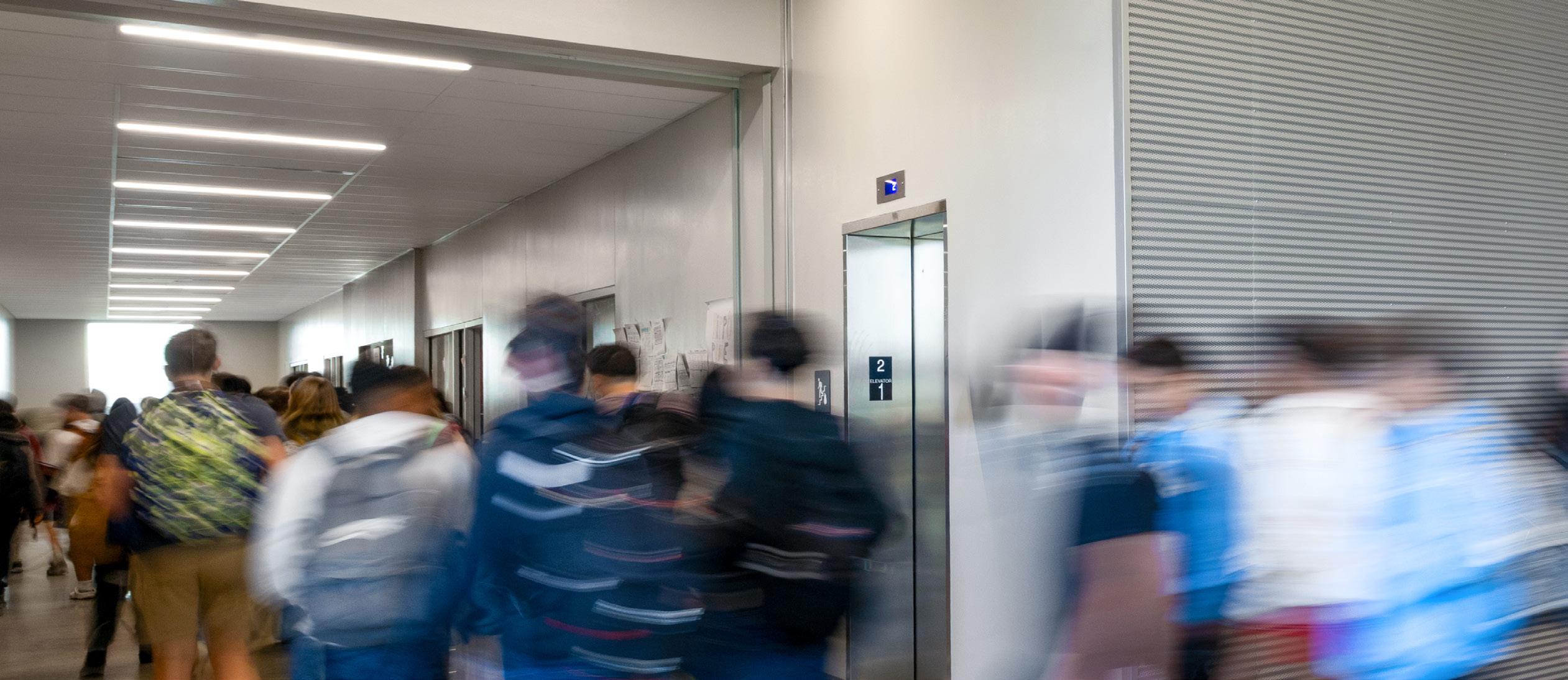
While public schools remain the most effective and efficient way to educate all children, some state leaders are actively working to divert taxpayer dollars into private school vouchers, or publicly funded subsidies. Most Texans don’t realize we’ve had school vouchers in Texas for roughly 30 years. Charter schools are essentially funded by vouchers. If I choose to unenroll my child from Rockwall ISD and enroll them in the charter school nearby, the per pupil funding allocated will leave Rockwall ISD and follow him/her to the charter school. And now, with well over 1,000 charter schools across Texas, no one can say parents don’t have choices. But that’s exactly what Governor Abbott is claiming. I guess he forgot about the charter schools. Vouchers are gifts of public funds, which I heard our Attorney General Ken Paxton declare live on air as illegal and unconstitutional when referring to the city of Houston wanting to create minimum household income grants. How are vouchers any different? Vouchers are often framed as “conservative” policy, but the truth is, the whole notion is the most liberal policy ever dreamed up by either party. They are unchecked gifts of public funds and an extraordinary waste of public dollars with no accountability to the taxpayers.
Public schools are governed by locally elected boards and accountable to voters. Vouchers take public funds and hand them to private schools with zero taxpayer oversight. These schools can reject students for any reason, aren’t required to meet the same academic standards (or any at all), and don’t have to disclose how they spend public money. Vouchers do not create choices for parents. They emphasize choice for private schools, including the choice to raise tuition when new dollars are injected into the market. Governor Abbott’s voucher proposal started as a $1 billion plan, but projections show it will likely balloon to more than $8 billion per budget cycle by 2029. And for what? Research at Stanford University found no evidence that vouchers significantly improved
student outcomes. (news.stanford.edu) Vouchers don’t improve education or save money—they weaken neighborhood schools by diverting funds and forcing program cuts. And despite the claim that they help struggling students, in other states, most voucher recipients were already in private schools before getting public money.
John Dewey, one of the most influential voices in American education history, once said, “What the best and wisest parent wants for his own child, that must the community want for all its children.” The fundamental purpose of public education is pretty simple: to ensure that every child, regardless of their background, has access to the same opportunities for success. Those pushing for privatization and vouchers often frame education as a personal choice rather than a collective responsibility. But education isn’t just about individual success, it’s about building a stronger, more equitable society where every child has the chance to reach their full potential.

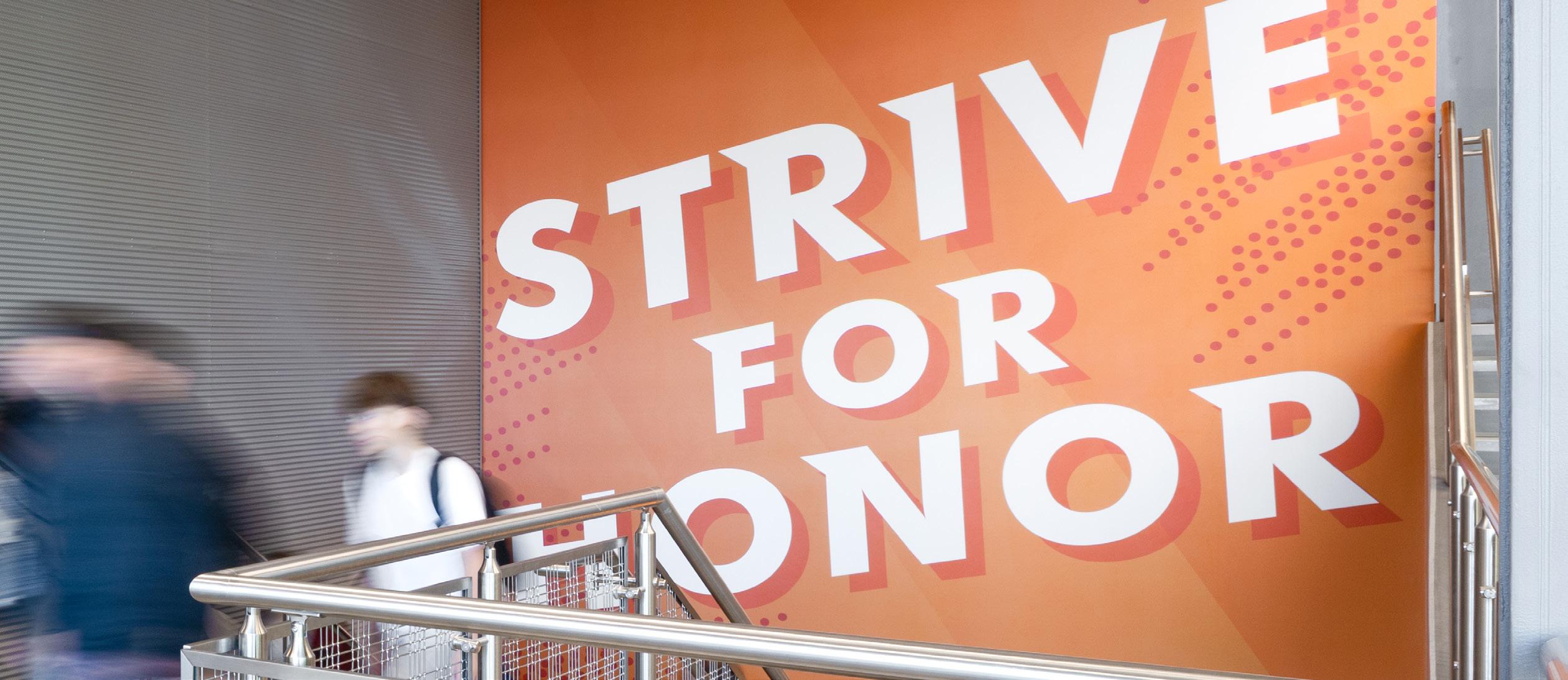
Now is the time to change the conversation about public education, to restore pride in our schools, to dispel the myths, correct the misinformation, and push back on disinformation. Despite the negativity, our schools are filled with dedicated professionals who go above and beyond every day for our kids. They need our support, not our condemnation.
The future of Texas depends on the strength of our public schools. Every child, no matter their background or zip code, deserves access to a high-quality education that prepares them for success. The attacks on our schools—through underfunding, misinformation, and political agendas—aren’t just harming educators; they’re threatening the future of our communities and our economy. The truth is Texas public schools are not failing. They are thriving, producing the workforce and leaders who keep our state strong. But they can’t keep doing more with less. If we want Texas to continue leading the way, we must reject the false narratives and fight for the funding, respect, and support our public schools deserve.
Public education is Texas’s greatest investment. It’s time we start treating it that way.
Be an advocate.
Speak up for your local schools. Defend the honor of your local educators. Call your legislators and tell them you want them to do all they can to support your schools.
Elect Texans who believe in public schools, who understand their role and value in our communities, and who will fight for fair funding and responsible policies.
Tell the real story.
Texas public schools are succeeding despite the challenges. Share their achievements, support your local educators, and help push back against misinformation. Vote.
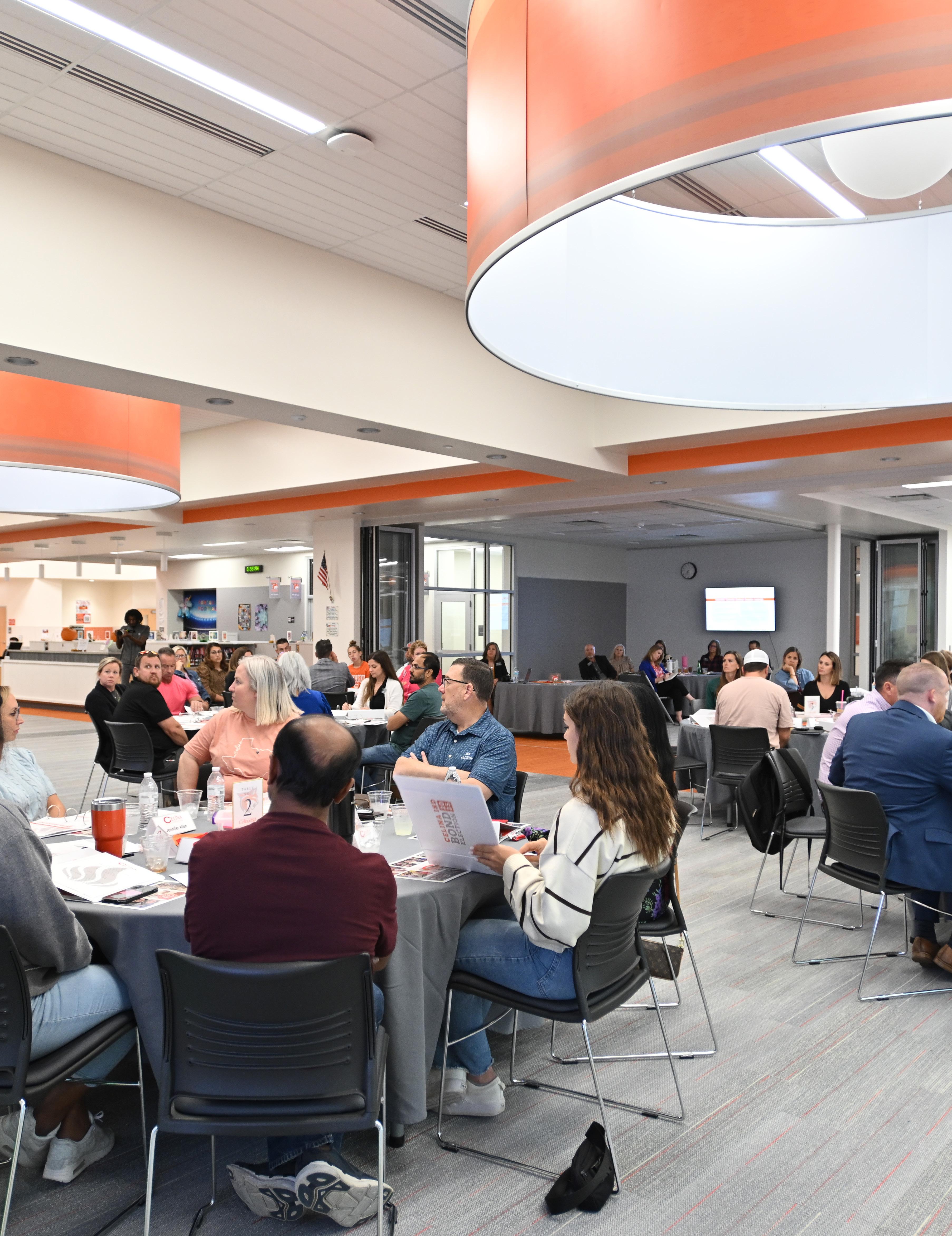
SARA KOPROWSKI, M.E d . | SENIOR ASSOCIATE, EDUCATIONAL PLANNER
RICK WESTFALL, E d . D . | SENIOR ASSOCIATE, EDUCATIONAL PLANNER
Today, public schools are some of the most important institutions in our societies. While they mirror our societies, they bring our ideals and our issues into focus. But in the contemporary world, characterized by the shifts in people’s values and beliefs, political polarization, and financial uncertainty, it is more complicated to build and sustain the trust between schools and the communities they serve. However, it is especially in these unstable conditions that such trust is necessary.
Community engagement in public schools goes beyond the mere attendance of events or meetings called by the schools. It is a mutual partnership between the educators, students, parents, the community, and other organizations to ensure that the school is a safe place for learning and positive development of the students. Studies have time and again shown that high levels of community engagement are linked with better student performance. According to the National Education Association (NEA), schools with high levels of community engagement have better graduation rates and academic performance (NEA, 2020). For instance, a study by the Harvard Family Research Project indicated that students in active communities are more emotionally balanced and have fewer cases of disciplinary problems (Weiss et al., 2005). The author of the report pointed out that family involvement at home, at school, and in the community makes a big difference in the child’s academic achievement, attendance, and behavior. The children who have a support system of the community members are likely to feel wanted and motivated to learn and excel in their academics and other activities.
Furthermore, in the modern world, schools are usually short of funds and therefore community partnerships are valuable assets. Relationships with local companies and nonprofits can help close the financial gap and provide students with more opportunities for learning. Such alliances, apart from improving the educational environment, also enhance the social and economic status of the community.
The development of trust is not something that can happen on its own, it requires effort and planning. Some possible ways schools can develop real community trust include the following:
Clear and Frequent Communication:
As a way of passing information to the community, it is important to ensure that each school has published clear policies, the latest curriculum, and scheduled events. Using different media channels like newsletters, social media, and community forums guarantees that no one is left behind
Decision Making That Involves Everyone:
Involvement of the various stakeholders in the community in decision-making processes creates a feeling of ownership and accountability. Creating advisory boards or holding town hall meetings is a great way to engage everyone in the conversation.
Honesty and Accountability:
Trust is well maintained when schools deliver on promises, reply fast to questions, and are open in their operations. This is because leadership with ethical standards deals with issues and provides solutions to them.
Partnership with Local Actors:
Interacting with local businesses, cultural institutions, and civic organizations can help to enrich the educational offerings and offer learning experiences that are relevant to the real world. These partnerships can also be seen as evidence for the school’s involvement in the community.
Celebrating Successes Together:
Celebrating the achievements of students, staff, and the community fosters positive relations and encourages a shared vision. Documenting progress and celebrating the small and big successes, at the same time, creates a bond.
Some good practices of community engagement in schools can be found in the following cases on the following page:

BRAZOSPORT ISD : BISD embarked on a comprehensive four-phase master plan to renovate Brazoswood High School, which entailed building a new high school facility, a multisport field house, and a new Career and Technical Education (CTE) building. The new CTE provides training in culinary arts, STEM, welding, manufacturing, veterinary science, floral design, health science, and information technology. These programs equip students with skills and certifications that prepare them for both college and future careers.
The involvement of community industry partners in the design of a new high school, particularly one focused on CTE, was essential to creating a future-ready learning environment. These partners played a vital role in aligning learning spaces, specialized equipment, and skill development with current industry standards, making education more relevant and engaging for students. Throughout the design process,
industry professionals offered valuable insights, constructive feedback, and real-world examples of flexible, authentic, hands-on environments that simulate modern workplaces. Their participation not only strengthened community connections but also helped establish clear pathways to student success through internships, mentorships, and job placement opportunities. The district and industry partnerships during the high school design process support a seamless transition from high school CTE pathways to future careers.
“The mission of Brazosport ISD is to graduate each student to be future ready and it is our belief that partnerships are vital to strengthening learning experiences for our students,” said Superintendent Danny Massey. “Through these partnerships with local industries and businesses, we have the opportunity to understand workforce demands to ensure we are graduating students with skills needed for high-wage and high-demand areas.”

WAXAHACHIE ISD : Due to the high rate of student population increase, WISD worked with educators, architects, and the community to design Waxahachie Creek High School. The new 520,000 sf campus, set to open in the 2027-2028 school year, will be able to handle up to 3,200 students. Design charrettes were a vital part of the VLK | LAUNCH® process for Waxahachie ISD, providing two collaborative, hands-on workshops where stakeholders could actively take part in shaping the vision and design for the new high school. These collaborative meetings brought together students, teachers, parents, community members, and district leaders to explore innovative ideas such as CTE programming, future-ready
learning spaces, and flexible environments into design concepts. The VLK | LAUNCH® process encouraged real-time feedback, collaborative teamwork, and creative problem-solving resulting in shared excitement and overarching design for the project. The project is a good example of how community engagement can lead to the development of facilities that are not only suitable for the current educational needs but also for the future. The project is a good example of how community engagement can lead to the development of facilities that are not only suitable for current educational needs but also for the future (VLK | LAUNCH®, 2024).

HOUSTON ISD : Condit Elementary, serving the Bellaire community, was shaped by strong parent, teacher, and community involvement throughout the design process. Stakeholders participated in a design charrette to help define the vision and goals for the new school, placing a strong emphasis on honoring the historical connection between the school and its community. At the forefront of the design was the desire for a transformational learning environment that reflected both the past and future of learning.
Bi-monthly meetings with the project advisory team ensured the continued integration of community values and historical elements into the evolving design. The overarching design concept, ‘Education is the Ribbon that Ties the Community Together,’ guided the entire process, inspiring a school that
is a connected collaborative environment and a reflection of shared history. This collaborative environment ensured historical features from the original 100-year-old building were carefully preserved and incorporated, while a timeline in the main hallway chronicles key moments in the existing school, the Bellaire community, and major historic events of the world. Shared spaces such as the gym, cafetorium, and outdoor areas are open for community use supporting a sense of pride, connection, and belonging.
“Condit Elementary is a special school,” said Principal Daniel Greenberg. “Thanks to the forward-thinking leadership of HISD, VLK and the community, the learning experience for Condit students reflects the times they are living in; a modern, 21st-century world.”


Thanks to the forward-thinking leadership of HISD, VLK and the community, the learning experience for Condit students reflects the times they are living in; a modern, 21st-century world “ “

Improved Student Motivation
Students are more likely to attend school on a regular basis, pay attention in class, and participate in other co-curricular activities when they have a community that supports them.
Stronger in Crisis
Schools that are based on trust can manage the challenges of health crises, natural disasters, or financial constraints with the help of their students, parents, and teachers.
Improved Educator Morale
Teachers work better in environments where their efforts are appreciated and supported, which leads to higher job satisfaction and retention rates.
Sustainable Community Development
The community benefits from a highly educated citizenry, who are more likely to be actively involved in the community and the economy.
In times of uncertainty, the relationship between schools and their communities becomes a vital source of strength. Building trust through open communication, inclusive decision-making, and authentic partnerships not only strengthens educational outcomes—it creates schools that reflect the values, history, and aspirations of the people they serve. This trust doesn’t just shape how communities feel about their schools—it directly influences how successful school projects become. When community voices are present from the beginning, as seen in Brazosport ISD, Waxahachie ISD, and Houston ISD, the result is more than a building. It’s a shared vision brought to life—where students thrive, teachers feel supported, and the community sees itself in every hallway, classroom, and common space.
National Education Association (NEA). (2020). The power of community engagement in education. Retrieved from https://www.nea.org Weiss, H., Caspe, M., & Lopez, M. E. (2005). Beyond the Head Start father involvement program: The Harvard Family Research Project. Harvard Family Research Project.
Brazosport Independent School District. (2023). Phase 3 for Brazoswood High School. Retrieved from https://www.brazosportisd.net/2019-2020_news/phase_3_ for_brazoswood_high_school
VLK | LAUNCH®. (2024). Waxahachie ISD: Engaging communities in school design. VLK Architects. Retrieved from https://www.vlkarchitects.com/case-study/ waxahachie-creek-high-school
Houston Independent School District (2018). Condit ES receives highest honor in school architecture competition. Retrieved from https://blogs.houstonisd.org/ news/2018/01/19/condit-es-receives-highest-honor-in-school-architecture-competition/ REFERENCES
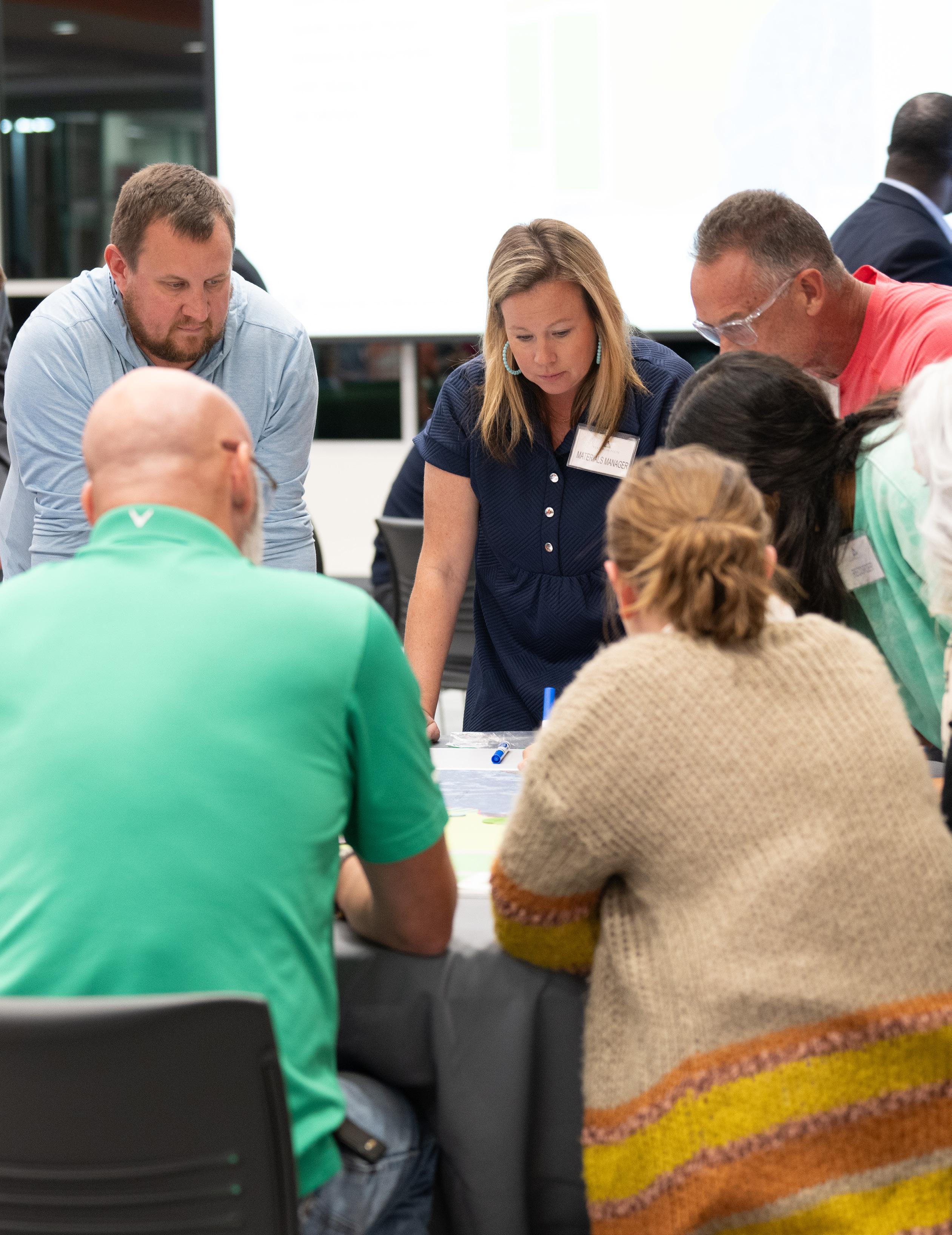
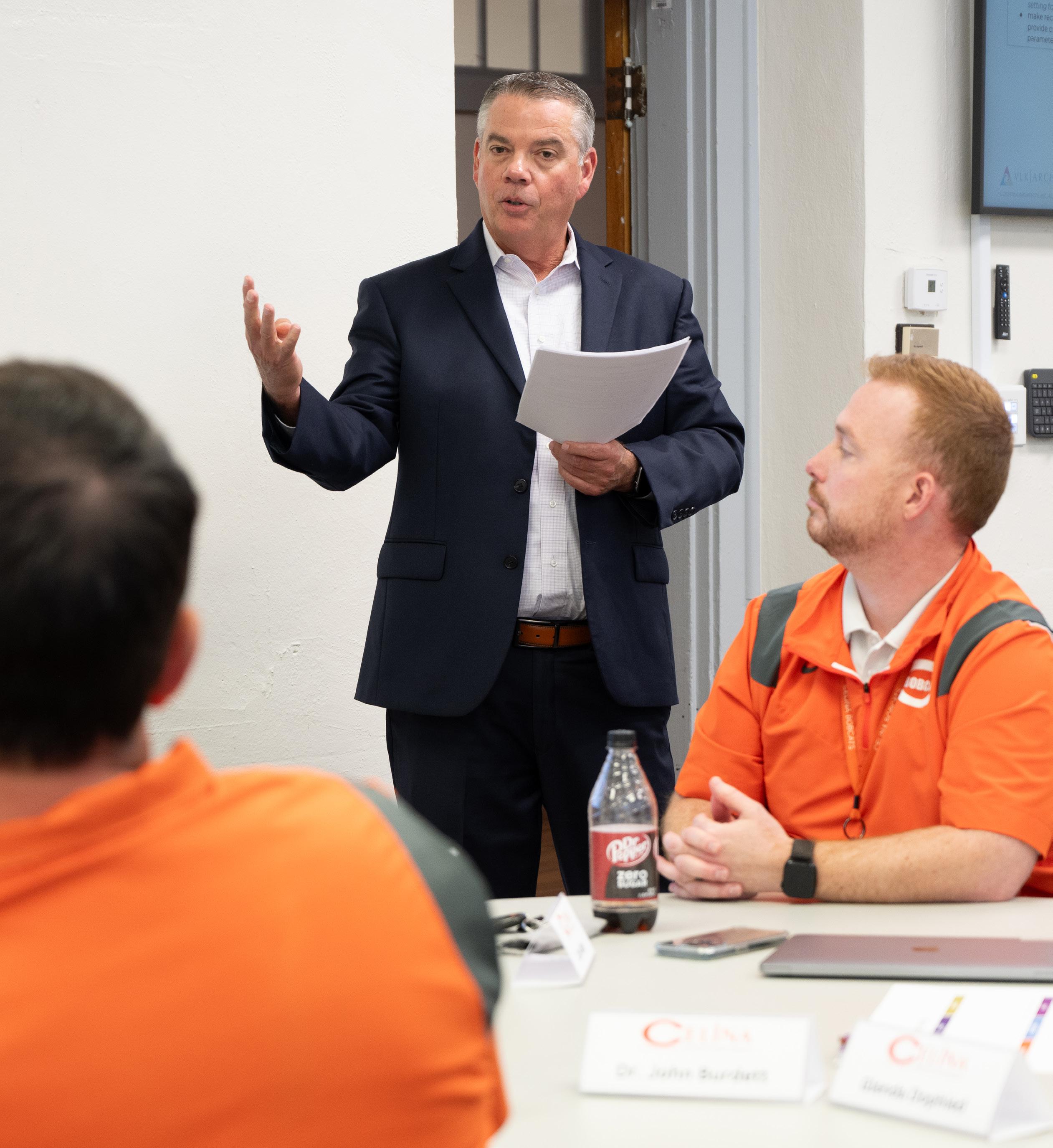
DALANE BOUILLION, E d .D | CHIEF DEVELOPMENT OFFICER
In a groundbreaking move, VLK is revolutionizing its offerings by venturing beyond traditional architectural services to encompass comprehensive educational expertise. VLK’s innovation in this arena began in 2015 when they added me as its first Educational Planner. Since then, VLK | EDGE® has grown its Educational Planners to include Sara Koprowski, Kevin Worthy, and Dr. Rick Westfall to continue to grow with client needs while bridging educational expertise and the design process, delivering outstanding learning spaces. This year marks a significant milestone as we proudly welcomed additional esteemed educators into our growing team, including Dr. Jim Chadwell, Superintendent Emeritus, Eagle Mountain-Saginaw ISD, Dr. Lizzy Johnson, former CEO of TransCend4, and Adi Bryant, former Chief Communications Officer of Royse City ISD.
With their wealth of experience and profound understanding of educational systems, VLK | EDGE® members are poised to not only provide educational planning expertise during the design process but also connect with other educators and educational leaders to either bridge gaps in existing district programs or extend district expertise with thought leadership. VLK is able to foster innovative solutions that cater to unique educational needs, bringing a wealth of experience in all areas that comprise a well-functioning school district. With leading figures in educational consulting, VLK’s expertise is amplifying our capacity to provide high-quality, additional, educational services to our clients. Our insights and strategic approach empower districts to optimize their programs and achieve their educational goals.
For example, in Denton ISD, VLK | EDGE® member Rick Westfall, Ed.D. and I are working closely with Superintendent of Schools Dr. Susannah O’Bara and her cabinet as they establish a new and refreshed strategic plan. The process for creating a strategic plan has evolved around the needs of the district and the direction Dr. O’Bara has chosen to go. As thought partners, VLK is deeply entrenched in the conversation while guiding the process and assisting based on our own experiences as educators. Whether it’s leveraging our vast educational experiences or deploying VLK’s XD video services,
our team has joined alongside the leaders in Denton ISD to help guide the direction of the district for many years to come. VLK’s foray into educational services underscores our commitment to holistic, client-centered solutions. By integrating expert educators into our team, we are uniquely positioned to offer an array of services that transcend traditional architectural boundaries, ensuring that our clients receive tailored, innovative solutions that address their specific needs. As we continue to expand and evolve, VLK remains dedicated to excellence and innovation in both architectural and educational domains. Our clients can expect unparalleled expertise, strategic thought partnership, and a steadfast commitment to enhancing educational experiences.
Join us in celebrating this exciting new chapter, where VLK not only designs outstanding learning spaces but also fosters transformative educational journeys. Together with our expert educators and educational leaders, we are again charting new territories and setting an increased precedent for integrated, forward-thinking, comprehensive services.


These are the first new elementary schools built in our community in over 70 years — and they have become so much more than just schools. They are places of connection, inspiration, and pride for the communities.
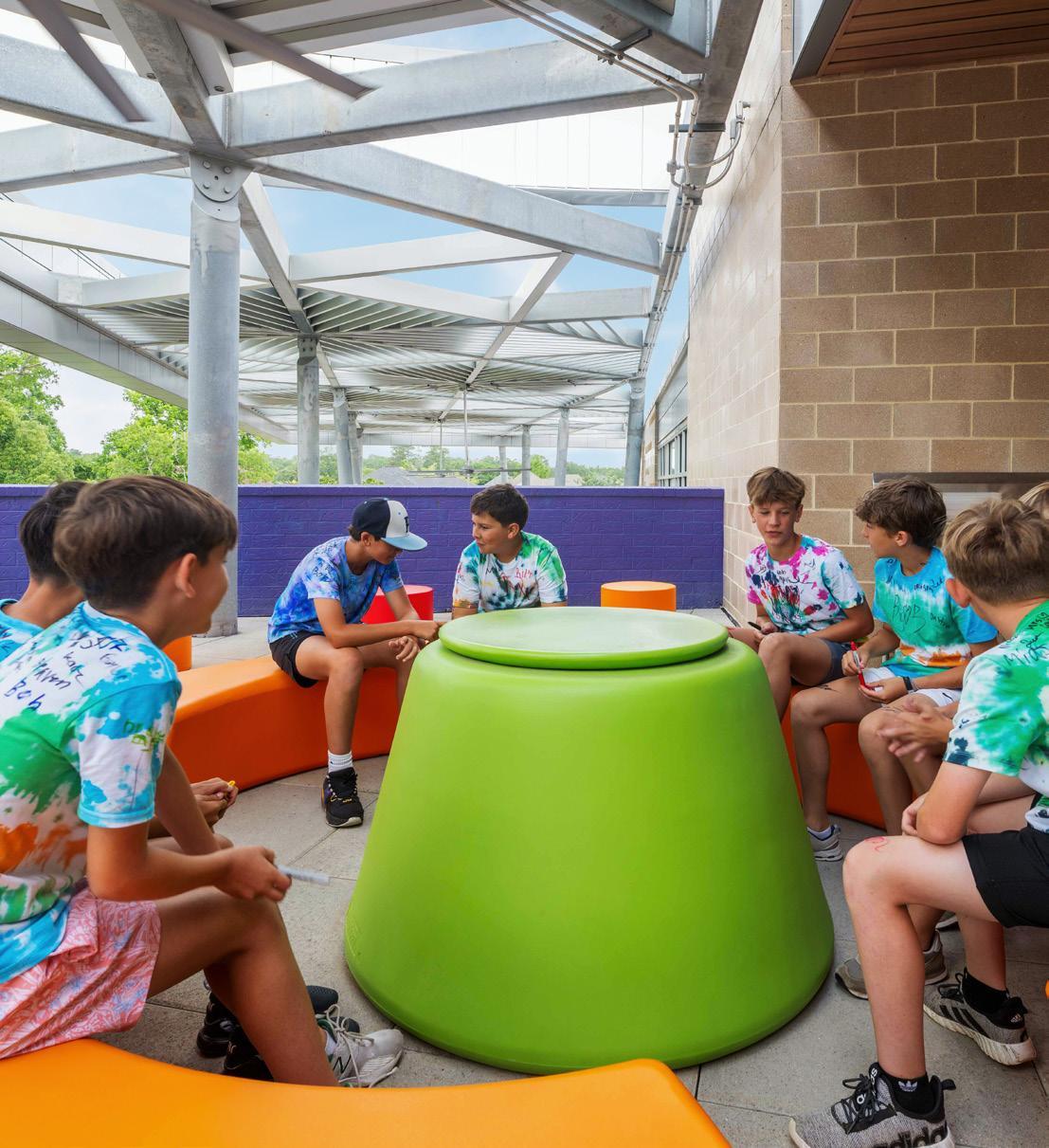

When a district has not built a new elementary school in over 70 years, the stakes for getting it right are high. You are not just modernizing infrastructure — you are redefining what school means for a new generation. In one close-knit district, a visionary superintendent, a deeply engaged community, and a focused design process came together to create something more than a new campus: they created a home away from home for young learners — their “Little Feathers.”
For Port Neches-Groves ISD, this campus began as a challenge: how do you unify two aging elementary schools, each with deep roots and distinct traditions, into a single campus that honors the past while building for the future? The answer? Thoughtful planning and consideration. By merging two communities into one purposefully designed school, the district not only reduced operational costs but also created an integrated educational environment that supports modern instructional approaches and strengthens connections across generations. The result is a future-ready facility that replaced 1950s-era schools with a vibrant, safe, and efficient learning environment that has become the pride of the community.
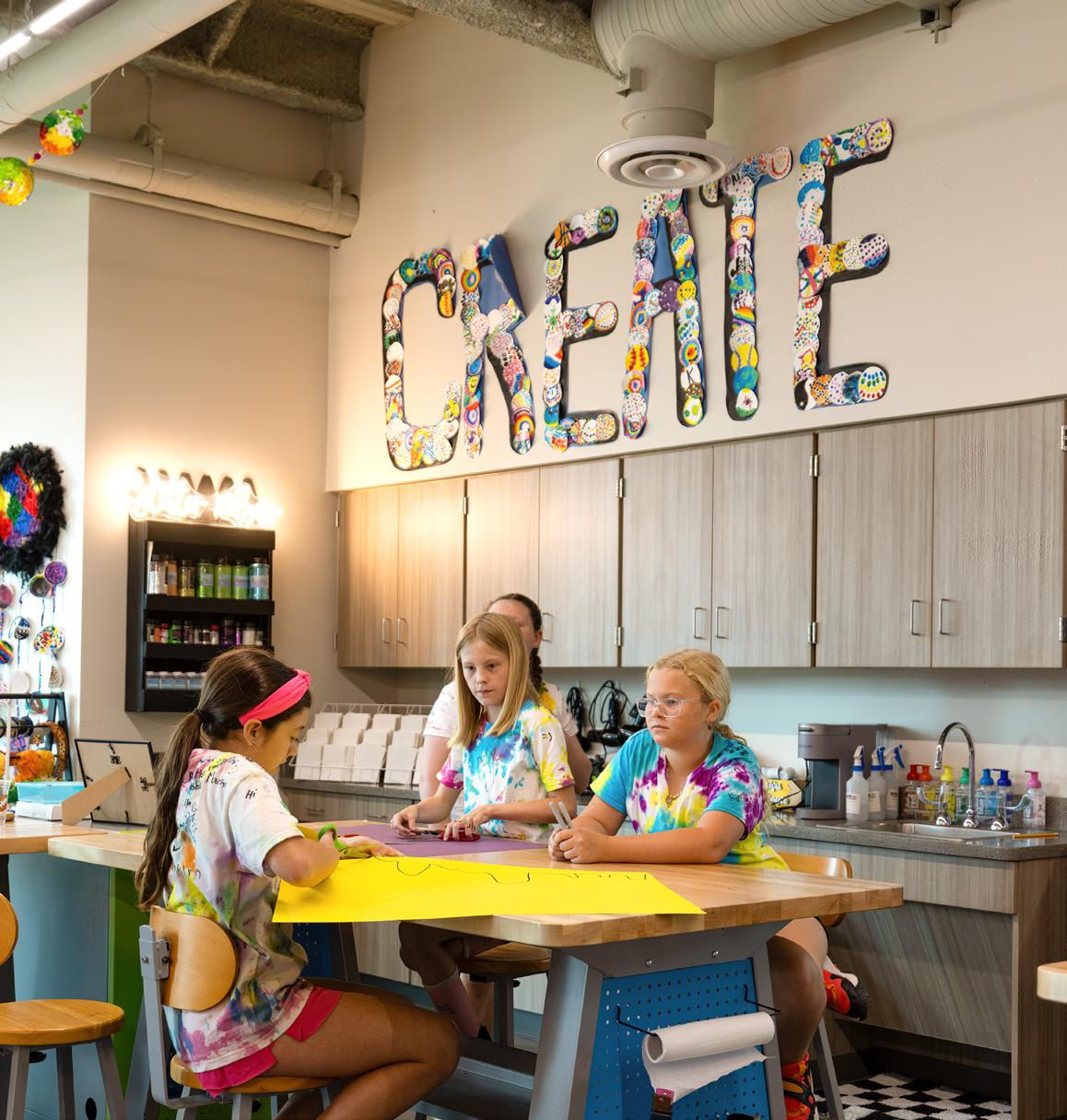
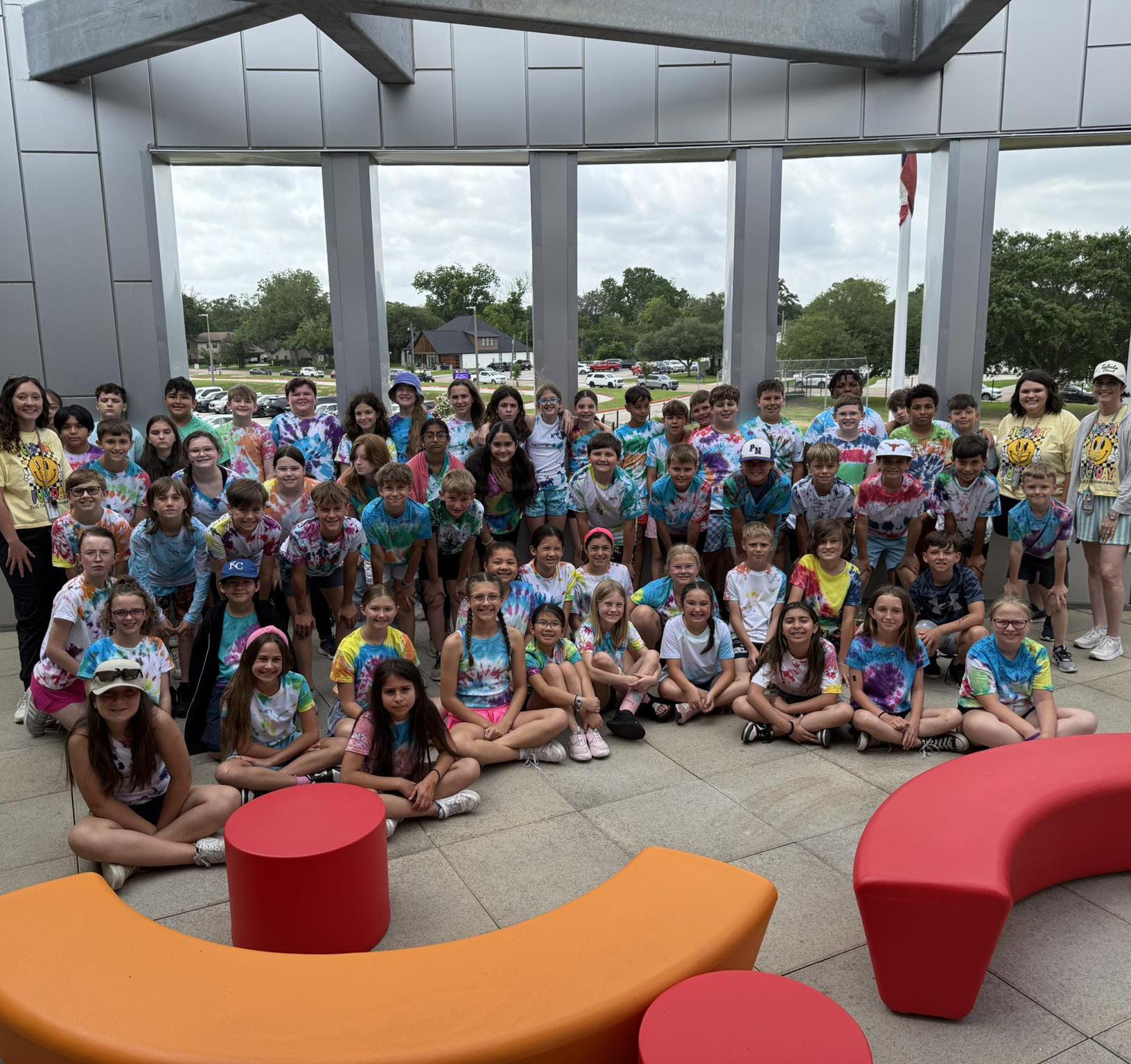

From the outset, the planning process prioritized collaboration. Administrators, teachers, and support staff were joined by an educational planner who translated curriculum aspirations into architectural design. Over 100 stakeholders participated in VLK | LAUNCH®, with student and parent voices and ideas at the forefront. The result is a school that reflects the lived realities and aspirations of its community. It’s not just a campus—it’s a community investment, shaped by the people it serves.


This building is so much more than just learning spaces, now representing honor, pride, and big tradition “ “
Whether it’s a school assembly, a theatrical performance, or a classroom presentation, the stage provides a flexible space that enhances the learning experience.

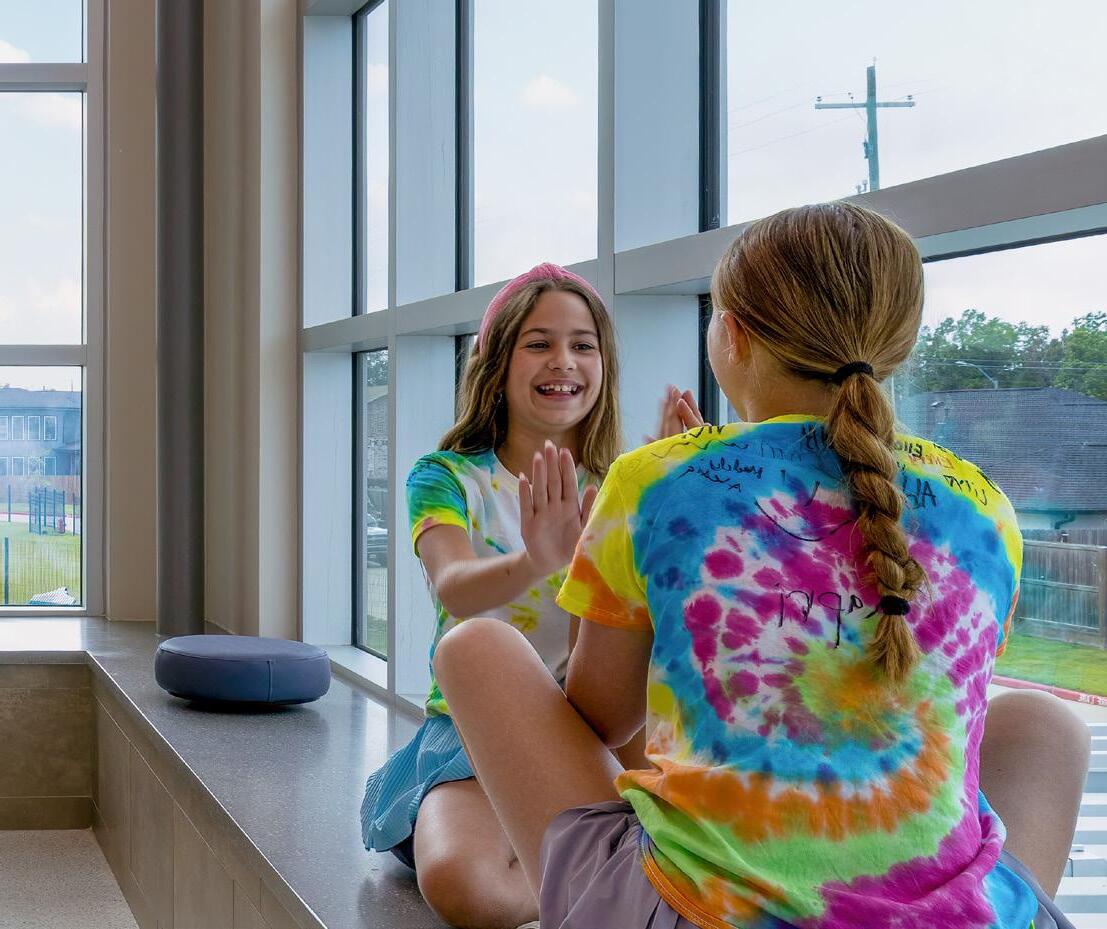
Every design decision supported fostering flexible, responsive learning that puts students first. Classrooms are oriented to the north and south, harnessing natural daylight and minimizing east-west solar heat gain, while shading devices provide additional energy savings. Inside, students are immersed in environments intentionally crafted for holistic development. Wide, light-filled “Living Rooms” offer a familystyle setting for collaborative projects and are also flexible to also offer a variety of small and large group learning configurations. A unique, two-sided stage and adjacent learning balcony reinforce the school’s flexibility, hosting everything from storytelling circles to science fairs.
As school leaders across the country seek to support students’ mental health and social-emotional development, this campus shows what it looks like in practice. Flexible nooks, cozy learning pods, and shaded outdoor zones give students space to breathe, connect, and take ownership of their environment. This is a school where every square foot tells students: you belong here.

The campus boasts enlarged traditional spaces for students, providing for big student opportunities. These areas are designed to accommodate a variety of learning configurations, from large group gatherings to small group collaborations.
This is a school where every square foot tells students: you belong here.
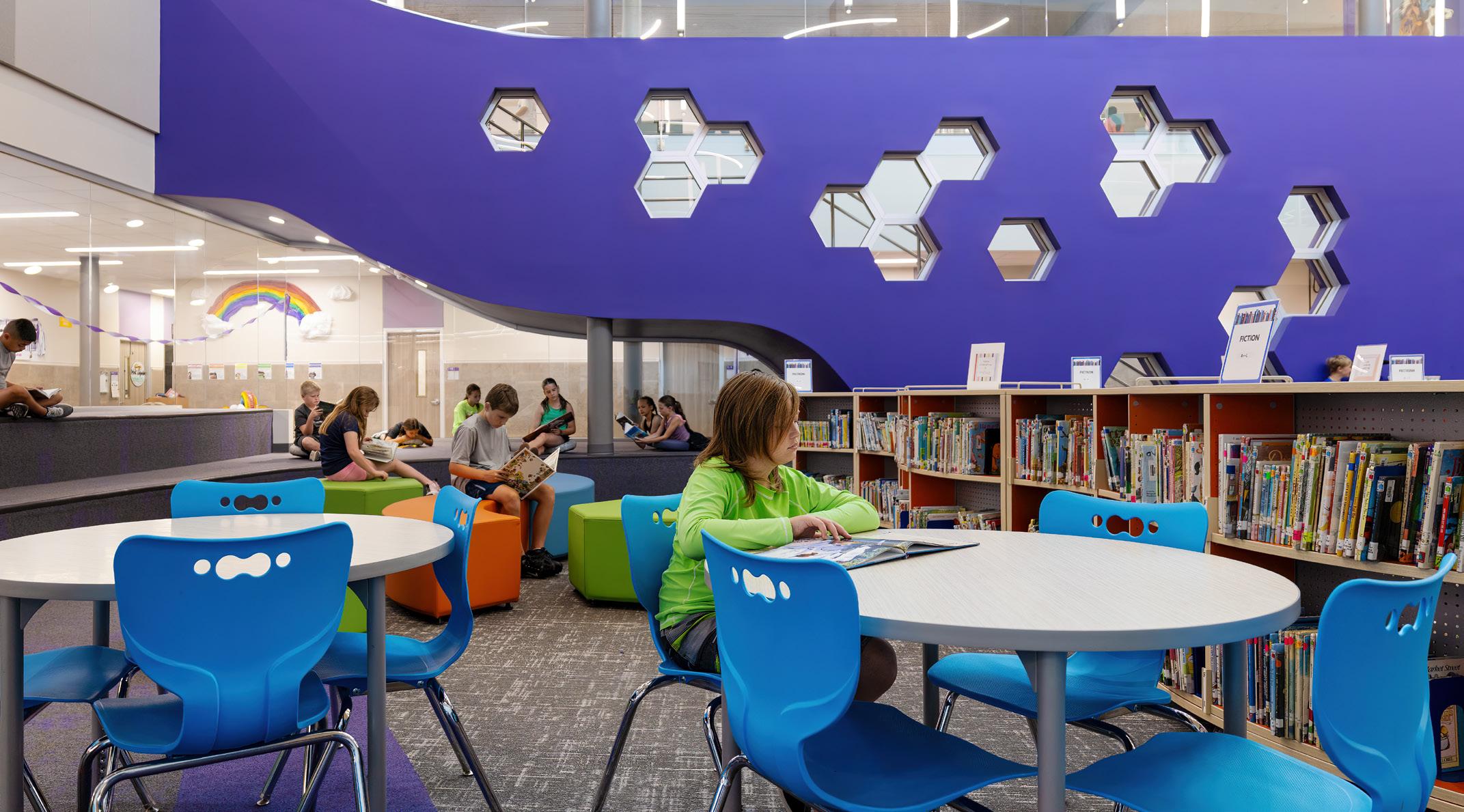
Students are seen using every inch of the building, from quiet corners to open terraces—because these spaces were designed specifically for their use. Comfort is built in. Pride is built in. And student behavior reflects that: engaged, confident, and connected learners moving through spaces made just for them.
Throughout the campus, the beloved district mascot, Little Feathers, appears in meaningful ways—on signage and as a unifying symbol woven into the design. The mascot is a visual reminder of the community’s shared values, legacy, and future. The campus doesn’t just support learning. It nurtures identity. It broadcasts belonging. It says to every student: this is your home away from home.



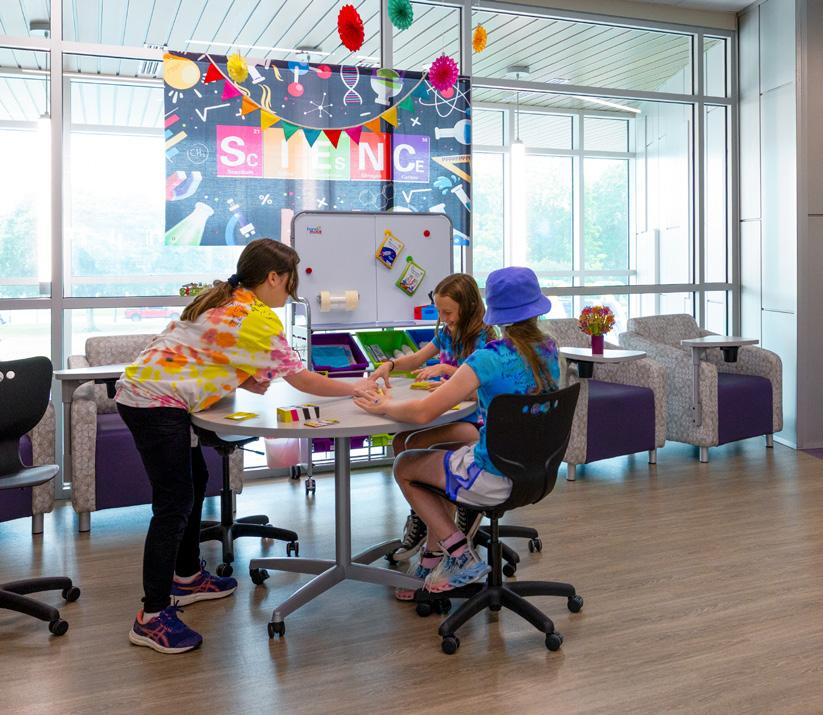
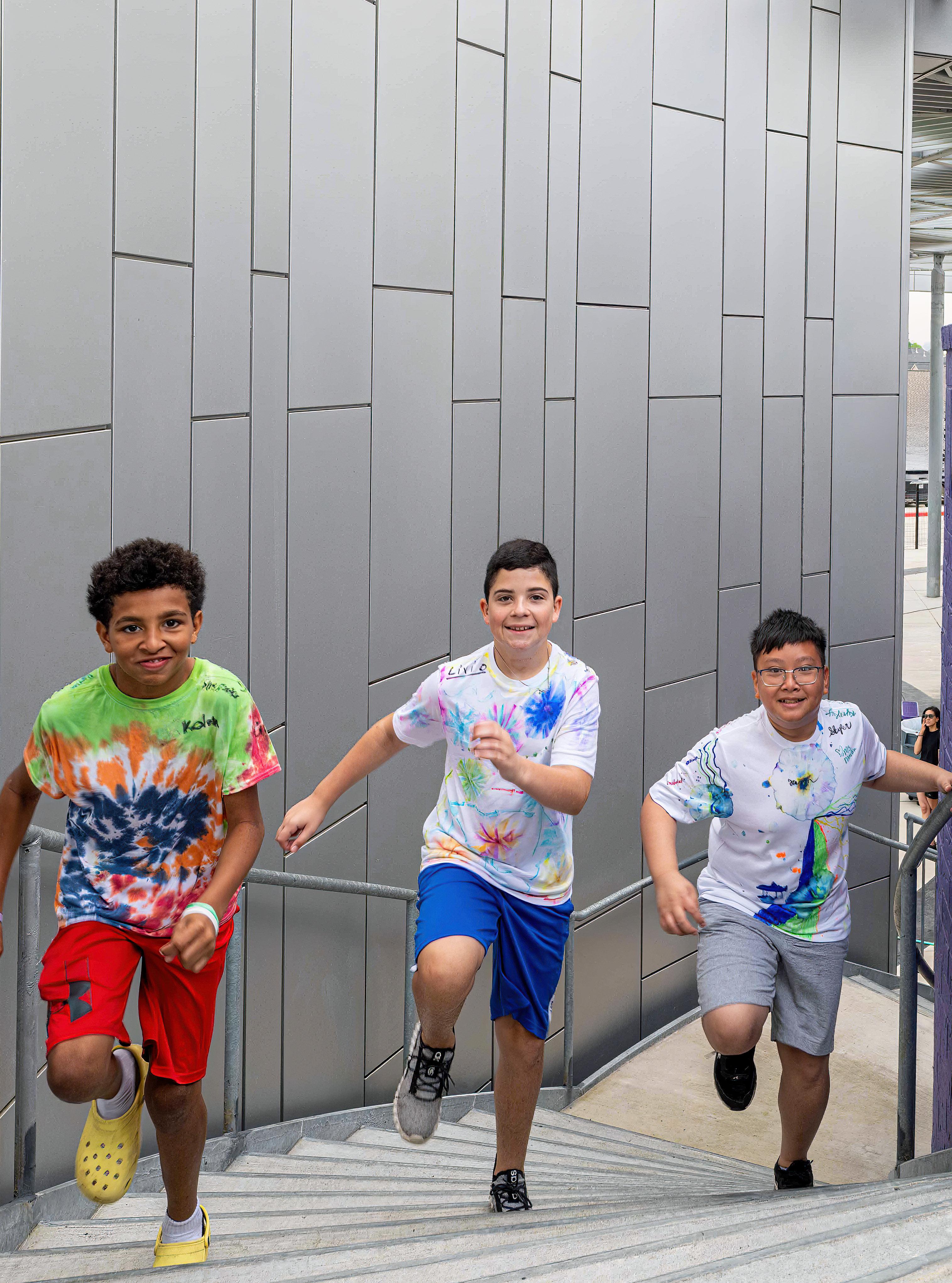
"Every time I step onto these campuses, my heart nearly explodes with pride. To see our teachers, staff, and students using these beautiful, intentional spaces in exactly the ways we envisioned — it's an indescribable feeling. These schools are not just buildings; they're the heart of our community."
Julie Gauthier, Deputy Superintendent, Port Neches-Groves ISD
The first time you encounter an AIA contract in order to negotiate terms on behalf of your district you may have been puzzled by the legalese, overwhelmed by the size, or concerned about unintentionally agreeing to unfavorable terms. It’s likely that the version of that contract came from the district attorney or was recycled from a previous project. Those in the Owner role view contracts as necessary, but often expect attorneys are the only ones who truly understand them or, if they are not being diligent that the architect will stack the deck in their favor. While contracts will never be a substitute for good communication, when understood and adapted appropriately they provide a framework for all parties to align expectations and ultimately reduce or eliminate misunderstanding and conflict. Let’s look at the current most common AIA Owner/ Architect agreement coming from the AIA 2017 suite of contracts and explore why these documents are so widely adopted and some common pitfalls we see regularly.
One might wonder how the AIA contractual documents became the industry standard, widely utilized by attorneys and architects alike. To understand this, it’s helpful to understand a bit of historical context. The American Institute of Architects (AIA) founded in 1857 is the largest professional organization

of architects in the world setting the professional standard for architects in the United States. The AIA published its first contract for use between an owner and a contractor in 1888, with a standardized General Conditions document following in 1911, and the first standard owner-architect agreement in 1917. Since that first contract, the AIA has leveraged a committee of internal experts, contractor/builder organizations, attorneys, and owner representation to adapt and supplement these documents regularly as the construction industry evolves. Since the 1970s this process has been revisited every ten years, with the current suite dated 2017, set to be updated again in 2027. These documents reflect a consensus of terminology and practice across the main parties (owner, architect, contractor) because of the collaborative and inclusive committee review process and are widely considered to be fair and appropriate baseline documents addressing with versions addressing common design and construction arrangements. These baseline documents are modifiable to incorporate unique project specific stipulations or other special arrangements that should be documented in the agreement, however, are sometimes extensively modified by an owner’s representative or attorney resulting in unintended or confusing requirements.
The typical owner architect agreement we utilize is the AIA B101-2017 Standard Form of Agreement between Owner and Architect, often referred to as the B101. This agreement defines the scope of work provided by the architect, the schedule of that work, and the compensation for those services. It outlines the responsibilities of the owner and architect by project phase (Schematic Design, Design Development, Contract Documents, Bidding, and Construction Administration), defines what is included in basic services (the essential core scope to be provided within the fee), items that are supplemental services (scope of services that may be required, but are outside of the basic service fee), and how to address items that are considered additional services (typically things that come up after the agreement is signed and are outside of the scope of the basic service fee).

School districts commonly publish their proposed forms of agreement as part of a Request for Qualifications (RFQ) for architectural and engineering services. At VLK, we like this as it lets us understand the terms we will be expected to agree to as we prepare our proposal and provides insight as to areas the district places value based on how they are delineated in the proposed contract. In the last few years, we have noticed heavily modified B101 documents that are potentially problematic. In some cases, large sections have been struck or replaced in their entirety, providing modifications that contradict, or alter wholly the intent of the section being revised. It is not uncommon for the modifications to double the size of the contract from the initial baseline. While we believe these modifications are being adopted out of a desire to protect school districts, some have ramifications that may not be fully intended, or could run in opposition to their intent. If an architect signs a contract that shifts the responsibility for non-negligent actions onto themselves or assumes the contractor or owner’s liability, they could void their professional liability insurance, leaving the owner at greater risk than otherwise. Terminology that is contradictory or open to interpretation could lead to more disputes, creating greater risk for an owner. It is important that the owner and architect review the contract language and discuss concerns to ensure the agreement works as intended for both parties. Some of the areas we have encountered that warrant significant discussion revolve around the following concepts:
BIM is the generic term for the modeling software that architects and engineers use to design and document buildings. It is different from the drafting software of the past in that it is modeled, or designed virtually in three dimensions, with team members accessing the model simultaneously and coordinating real time. From this model, the construction or bid documents are derived. In most cases, the model is created to facilitate coordination of the design team and consultants and is leveraged to get information onto digitally printed sheets that are issued for bidding and construction, becoming the contract documents. These documents are sealed by the architect and engineers per their state licensing boards requirements and must be handled accordingly or risk sanction, disciplinary action, or revocation of their license. The construction documents are provided to the authority having jurisdiction (AHJ) for permitting and regulatory review and approvals. The model or CAD derivations are not intended to replace or supplement
the legally defined construction or contract documents. It is important for language like that in section 1.3.1 remains as it provides an avenue for definition of expectations around the level of detail, sharing and utilization of the BIM model. Additionally, ownership of the BIM model and contract documents needs to be addressed, balancing the architect’s intellectual property with the district’s ability to maintain and modify their facility. As a district, it is important for you to decide how or even if you will utilize the model in the future, what the model includes (Level of Development- LOD 100-500), and how or if it is updated during construction. Providing a model reflecting the as-built conditions has cost implications for the design team as well as the contractors involved and is more expensive to try to accomplish retroactively than at the inception of the project. You wouldn’t want to have those costs built into the fee if the district doesn’t have the desire or software to utilize the model.
It is traditionally the responsibility of the district to provide information on the site to be used, including various surveys, a geotechnical soils report, existing building documentation, etc. The standard agreement anticipates the district will provide a program for the facility to be designed, including a list of spaces, sizes, and other standards to be considered during the design process. School districts also typically provide Technical Design Guidelines (TDG), and their Strategic Plan document. These items not traditionally considered part of the architects’ scope can be included but need to be understood as part of the agreement.
Insurance levels required of the architect should reflect the size, scope, and scale of the project. Architects often carry levels of insurance appropriate to the amount of work they undertake; however, the cost of additional policies required to do business with a district beyond what would be considered typical will be passed through to the owner during fee negotiations. If these levels are not actually providing value to the owner, that additional cost may not be warranted.
At VLK, we have seen contracts that stipulate the architect will certify the contract documents are “materially free of defects and omissions”. While this seeks to reduce the district’s risk, agreeing to this language could void the architect’s professional liability insurance for the project, which would clearly not benefit the district. Contractually speaking the architect certifies only two documents, the pay application and the certificate of substantial completion as there is a higher standard around certification as a contractual term and it should not be applied to other areas without attorney and insurer consultation. No architect, owner, or contractor is perfect and agreeing to, or expecting, perfection is likely to lead to disappointment and disputes. Under the standard language of the contract, the architect is held to the standard of care, which is a widely recognized and understood legal term that essentially means we are held to the level of reasonable and prudent architects in similar circumstances and locations. Agreeing to providing a level of care beyond that level, also recognized by the state licensing board, could cause the architect’s insurer to refuse coverage should an issue arise.
Additional language around breach of contract has been showing up in various areas of a contract where a district may be concerned an architect could fail in their responsibilities. If the purpose of this language is to provide a way out of the contract, we believe it is redundant. In most contracts, either party, owner or architect, is allowed to terminate the agreement for convenience, that is allowing for termination of the agreement without exhaustive documentation or reason required. Adding that language to specific actions in a document that defines the terms of the contract theoretically breached implies some higher level of scrutiny on those items relative to the other contractually defined actions. This leads to confusion, which is typically interpreted as risk, and ultimately manifests in fee to offset that potential risk. If you have specific concerns around certain responsibilities, those should be discussed and appropriately documented to avoid uncertainty or inflation of fee.
Article 4.1.1 of the B101 includes a responsibility matrix of Supplemental Services and designating them as Owner, Architect, or Not Provided. It is important for a district to understand what each of these services are, if they are or might be required, and if they are to be included in the architect’s basic services or supplemental services. At VLK, we have noticed more services being added to the list and more items listed under the architect’s basic services. Any items not providing value to the district or the scope is not defined at the time of the agreement are likely to result in increased fee. Items historically attributed to the owner include the upfront information required to begin design, such as programming, site surveys, existing drawings, and reports. Traditionally, the owner will retain some consultants required to complete the construction documents, or they are compensated outside the architect’s fee. These are typically site-related, like civil engineering or landscape architecture, or
are specialty consultants such as food service, acoustical design. Commissioning is a service on this list that recently shows up as a basic service of the architect. Commissioning is intended to be a third party not aligned with the architect, engineer, or contractor who verifies specific systems are functioning as designed on behalf of the owner. It is important, and sometimes code required, that commissioning be performed independently as it may identify design or installation deficiencies. There are other services listed that are not typically required in school design like tenant-related services, and services that are contractually the responsibility of the contractor, like as-built drawings that have sometimes been included in the architect’s basic services and should be reviewed prior to agreement. It is important that this list becomes a tool for discussion during negotiations to make sure both parties understand the meaning and intent of each line item to avoid additional cost that may not provide the intended value.

The General Conditions document A201-2017 exists to provide a framework outlining the rights, responsibilities, and relationships between the district, contractor, and architect in a construction project. It is typically included as an exhibit to the Owner/ Contractor agreement; however, it directly pertains to the Owner/Architect agreement as it outlines responsibilities of the architect during construction. If the General Conditions are to be edited from the baseline or replaced in its entirety, they, like the proposed contract, should be available for consideration in its final form during the RFQ process and contract negotiations between the district and architect to ensure an alignment of expectations.
It should be of no surprise that when it comes to contracts, words are crucially important. Often the expectation for the standard of care is increased in an effort to protect the district by inserting language such as, “The architect shall exercise ‘the best’ professional judgement.” This is problematic again because it implies a level beyond the industry standard level of care expected and anticipated in the architect’s professional liability insurance.
Another area where districts have added services to the B201 has been in the escalation of required site observation. For example, we’ve seen requirements set for observations one or two times a week, regardless of the point of construction. Other examples include a requirement for a representative present for all concrete placement or requiring the architect to be responsible for the contractor’s deficient work that gets covered up. It is important to understand that there are several layers of oversight built into the modern construction project. The architects and engineers are involved in construction to answer questions, review products and details and observe the quality of the work. The AHJ provides inspections for a wide range of construction items that are required during installation to issue the Certificate of Occupancy. The owner engages a third-party materials testing agency to take samples and conduct testing during construction for items like soil density, depth of bearing
strata, concrete slump and strength, and steel welds. The standard building code requires a series of special inspections for items like masonry that are deemed critical to public safety. All of these items should be considered as the appropriate level of site observation is determined. Some districts have used language like “inspection” in lieu of “observation”, which implies a higher level not typically used to describe the architect’s observations in the field. Some contracts require certification that documents comply with government or accessibility codes. Historically architects have certified only the pay application and certificate of substantial completion. Some of these stipulations if agreed to would amount to exhaustive or continuous site observation. We believe the interval of observation should be appropriate to the speed, scale and type of work undertaken at that point of the construction episode.
While these are important considerations, what we at VLK have found to be most important above all is transparency. We pride ourselves on enduring relationships with our clients, all of which is built on trust. Anyone who has worked with us has no doubt found us eager to listen and learn. And that is never more important than when discussing contracts. You can trust that when we discuss an agreement with you, we aim to help in drafting a contract that is clear, fair, and has the greatest potential to lead toward the successful completion of your project.
In 2025, the Texas Legislature approved what had eluded it for nearly 70 years: a statewide school voucher program. Known as Educational Savings Accounts (ESAs), this new entitlement program will allow families to use public funds to send their children to private schools or to homeschool at taxpayer’s expense beginning in Fall 2026. Although proponents have long framed the idea as “school choice” or “parent empowerment,” the realities of the program tell a far more complicated and far more costly story.
JIM CHADWELL, E d.D. | SENIOR ASSOCIATE, K-12 SPECIALIST
Texas lawmakers have debated voucher programs since the 1950s, when initial proposals were floated in response to desegregation orders following Brown v. Board of Education. For decades, these efforts failed. School vouchers were broadly unpopular with Texans, especially in rural areas, and these bills were defeated every session.
That changed in 2025, when the 89th Legislature, with strong backing from the Governor and political advocacy groups, passed a voucher/ESA program into law. The victory came after an aggressive campaign to replace pro-public education lawmakers with voucher-friendly candidates and threats of primary challenges for dissenters. While the program is pitched with feel-good phrases like “let the money follow the child,” it ultimately creates an entitlement program funded by Texas taxpayers with little accountability and results in significant negative consequences for public education.
Launch Funding: Senate Bill 2 allocates $1 billion for startup implementation in 2026, with projected costs reaching $5–7 billion after the first biennium.
Voucher Value: Students will receive approximately $10,000. Special education students may receive up to $30,000. Homeschool students will receive $2,000–$2,500.
Private School Costs: The average private school tuition ranges from $11,000 to $14,000 per year, with elite institutions charging up to $40,000 annually, which is well above the voucher amount.
In states with established voucher programs, like Florida and Arizona, 75% of students receiving a voucher were already enrolled in a private school; however, in Texas there are restrictions that at least 80% of voucher funds must be allocated to students with financial or special-needs priorities. There are twice as many homeschool children as private school students and homeschool children are more likely to financially qualify for the program, which has eligibility requirements that prioritizes students with financial need.
Private schools can admit or reject students at will. Parents lose access to grievance procedures, elected school boards, or curriculum transparency. There is no guarantee of transportation, special education services, or free meals.
Had the $1 billion voucher funding been allocated to public schools, it could have raised the basic allotment by $182 per student. Instead, schools lose enrollment-based revenue they cannot quickly recoup by reducing costs.
There are no academic standards or fiscal accountability measures built into the program for private or homeschool providers. This sets the stage for misuse of funds, inadequate instruction, and long-term inequity.
Private schools and homeschools serve a valuable role for families who voluntarily opt to pay for a different model. But vouchers shift the burden of that choice onto the public. Also, it is likely that future legislatures will mandate state requirements onto these schools, just as they have for charter schools over the years.

MICHAEL MARTINEZ | PRINCIPAL
School districts have been negatively affected by a lack of school funding and have had no significant budgetary increase since 2019. The funding appropriated to them during the 89th Legislative Session does not take into account districts’ systemic deficit budgets, additional unfunded mandates, the inflexible limitations in how the funds are required to be used, and vuchers. As districts face a shifting landscape of enrollment and funding, strategic leadership will be critical. North East ISD (NEISD), under the leadership of Superintendent Dr. Sean Maika in San Antonio, has become a case study in how to respond with vision rather than fear.
When NEISD surveyed families to identify what they valued most, the message was clear: trust in the people who serve students every day, such as teachers, bus drivers, and custodians. The district launched a campaign to highlight these professionals through web and social media stories. Community members were invited to contribute their own narratives, building pride and connection around shared values.
Transparency is important for school districts and supports a culture of trust; however, clear expectations must be set so that it is not devolved into a demand for exhaustive information that creates an untrusting environment between the district and the community. Dr. Maika references Simon Sinek who poignantly notes that “giving context is most important.” Transparency without context breeds confusion. NEISD leaders have adopted the philosophy of Simon Sinek, focusing on the “why” behind decisions. By explaining reasoning in accessible ways, whether about school safety, consolidation, or budgets, the district builds understanding and support, not just compliance.

NEISD showcases programs like the Institute of Cyber Security & Innovation, where students graduate with industry certifications and land jobs straight out of high school. One student, for example, beat out 125 adults to secure a position with the National Security Agency. These are real-life success stories that only public schools, with their scale and scope, can deliver. By highlighting such compelling stories and unique educational programs, ISDs can significantly enhance their appeal to families seeking valuable, real-world opportunities for their children that are only available in a traditional public school.
Effective financial planning and resource reallocation are vital for school districts, especially considering the negative funding effects from the implementation of a voucher program. To navigate these changes, ISDs have remained agile and forwardthinking to mitigate potential financial disruptions. There are many significant challenges arising from the growth in school choice options, such as charter schools and homeschools, as well as the impending negative effects of lost enrollment due to the voucher programs. They realized that framing the issue solely around financial concerns would lead to community dissatisfaction, prompting use of their transparent and contextual communication strategy. NEISD goal was to “make the invisible, visible.” Rather than framing changes like campus closures as losses, NEISD engaged the community in reimagining campuses. Former schools now house programs like the Academy of Creative Education, an innovative campus serving at-risk youth. Through redesign and inclusion, the district addressed needs while also protecting public trust.
JIM CHADWELL, E d.D. | SENIOR ASSOCIATE, K-12 SPECIALIST
The story of school vouchers may seem new, but other states have written this script before, and the outcomes are often the same. The chronology of events is painfully familiar:
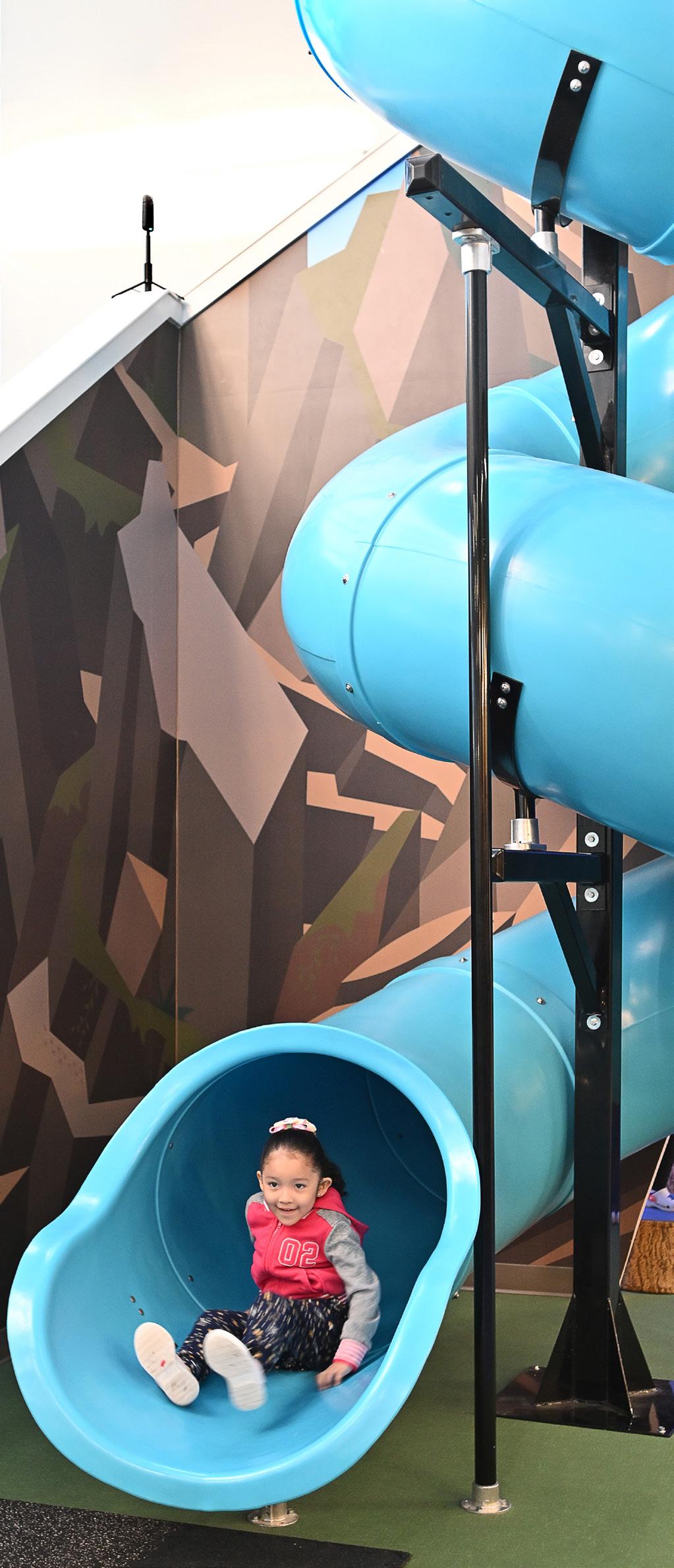
Implementation Begins
Vouchers roll out with little long-term cost analysis.
Access Remains Unequal
Low-income families struggle to participate. Private school costs, lack of transportation, and selective admissions limit access.
Public Funds Flow to Private Students
Eventually, the majority of recipients will be those who never attended public schools, making the state responsible for significant new costs.
Costs Soar
As more families apply, funding becomes unsustainable, especially during statewide economic downturns.
Educational Quality Declines
Private voucher schools often employ uncertified teachers, lack special programs, and fail to meet public school standards.
Corruption and Fraud Surface
With few oversight measures, misuse of funds becomes more common.
State Increases Oversight
What begins as “freedom” results in regulation, limiting private and homeschool independence.
Neighborhood Schools Close
Districts face enrollment declines, fixed costs, and bond debt for underused facilities.
Public Backlash Grows
Communities lose neighborhood schools, feel betrayed, and trust in state and local leadership erodes.
Political Will Shifts
As financial instability increases and dissatisfaction grows, lawmakers reverse course ending voucher programs altogether
The main question is not if this will happen, but rather when it will happen.
Despite the coming challenges, this is not a story of defeat. Across Texas, teachers, administrators, and school communities remain committed to serving every child, regardless of zip code, income, or need. But they cannot do it alone.
Voucher programs divert billions of dollars away from public schools without delivering on their promises of access, equity, or excellence. They create an entitlement system with few protections for children or their families and there is no accountability for academic outcomes. If Texas is to preserve its public school system, the backbone of its communities, it must recommit to investment, transparency, and local engagement. That starts with holding lawmakers accountable, amplifying public voices, and refusing to let political ideology dictate the future of our children.
This moment requires persistence, clarity, and unity. The promise of public education in Texas, our greatest civic inheritance, is too important to abandon. We owe this to our children and our children’s children.

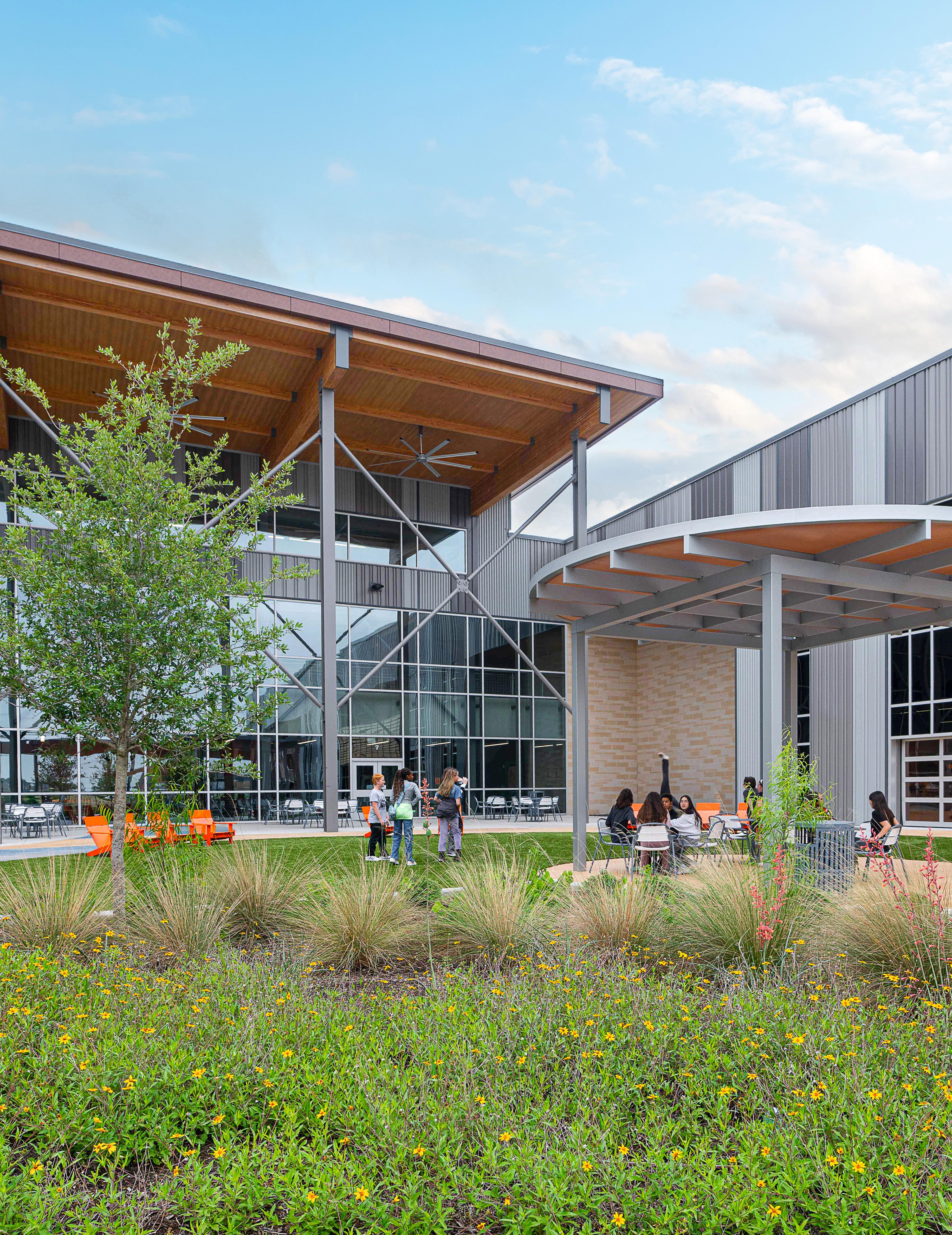
As we look to the future of public education, I am reminded that schools are not simply buildings—they are the foundation of our communities, the engines of opportunity, and the embodiment of our shared civic values. At VLK, we have always believed that our responsibility extends far beyond designing walls and roofs. It is about shaping environments where students, educators, and communities can thrive.
Today, that responsibility has never been greater. Public schools across the nation face mounting pressures—financial, political, and cultural—that threaten to erode the very system that has prepared generations of leaders, innovators, and citizens. Yet amid these challenges, we see a moment of extraordinary possibility. This is a time not to retreat, but to lead.
The articles in this issue remind us that advocacy is central to our mission. We stand alongside educators, administrators, and communities in defending public education as our states’ most vital investment. Our role is not only to design schools but to give voice to the truth: that strong public schools are essential for a strong republic. We are committed to helping our clients navigate this shifting landscape with clarity, creativity, and courage.
The future of education will be deeply influenced by emerging technologies, particularly artificial intelligence. At VLK, we are leveraging AI to transform design, operations, and learning itself. From predictive analytics in facility planning to personalized educational experiences, we are reimagining how schools serve students. But technology must be harnessed with responsibility and humanity. We believe that innovation should amplify, not replace, the relationships at the heart of education.
VLK is the foremost architectural design firm in education, but we are also thought partners, bringing deep expertise to the pressing issues that districts face. Whether it is guiding long-range facility planning, fostering community trust, or advocating at the state level, we embrace our role as conveners of ideas and stewards of public trust. Our clients know that when they work with VLK, they gain not only design excellence but also strategic partnership.
As highlighted in this issue, our team has grown to include leaders with decades of experience as superintendents, educators, and communications experts. This expansion allows us to support districts in new and holistic ways. By integrating these services with our architectural expertise, we offer a comprehensive platform of support for the evolving needs of school districts. At VLK, we know that the future of public education will not be defined by obstacles, but by the collective will of those who believe in its promise. We are proud to stand at the forefront of this movement—as advocates, innovators, and partners— committed to designing not only schools, but futures.
Together, let us continue to champion public education, harness innovation responsibly, and build communities where every child can thrive.

SLOAN HARRIS CHIEF EXECUTIVE OFFICER, PARTNER
